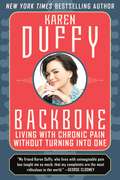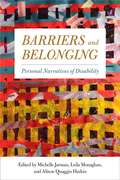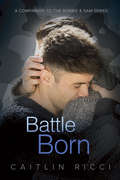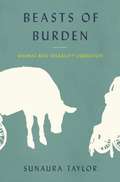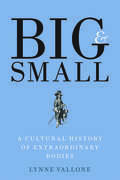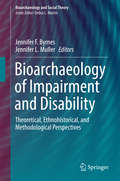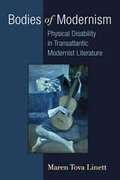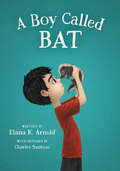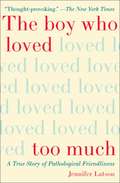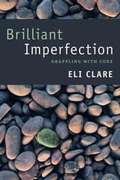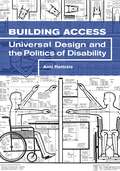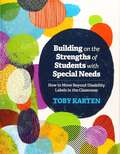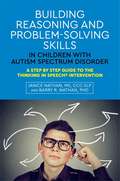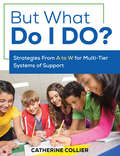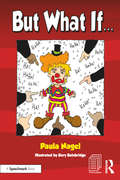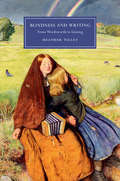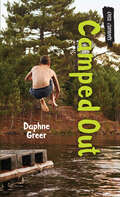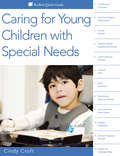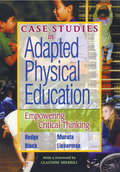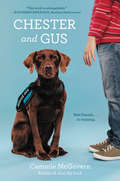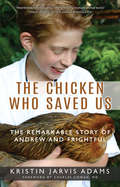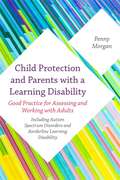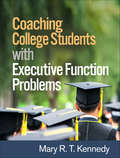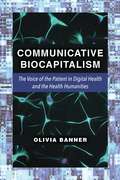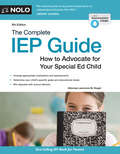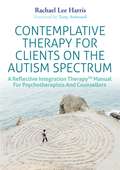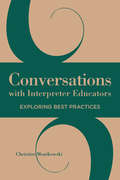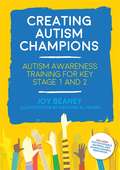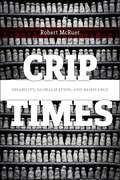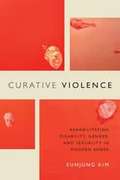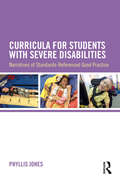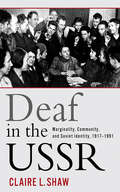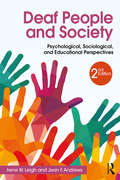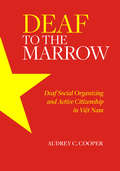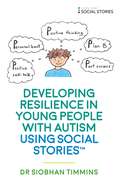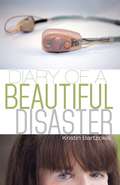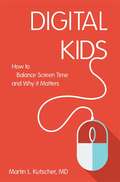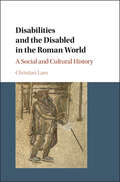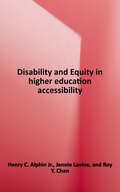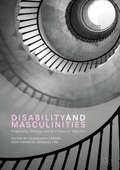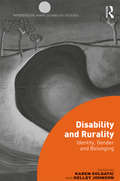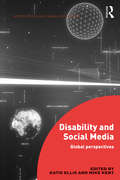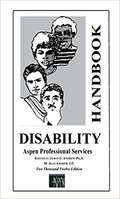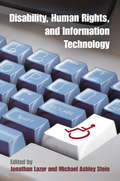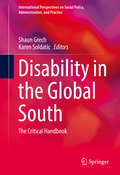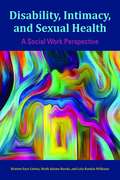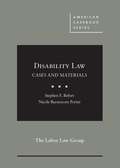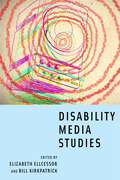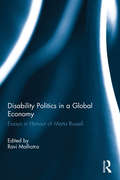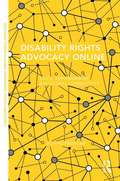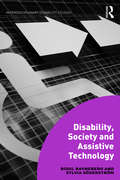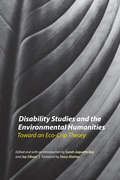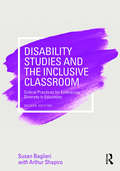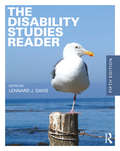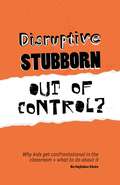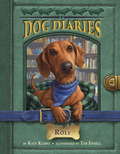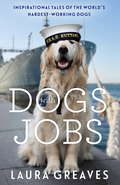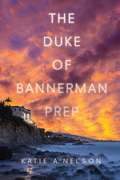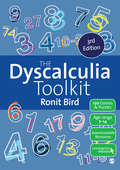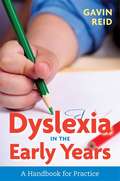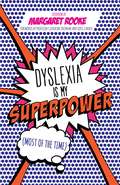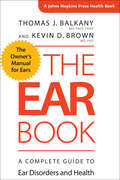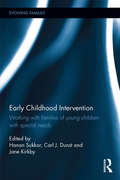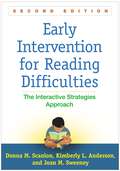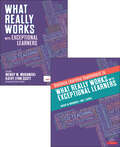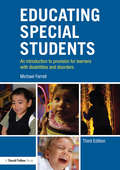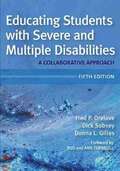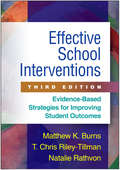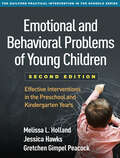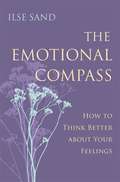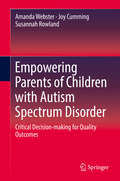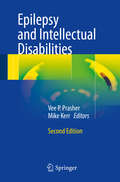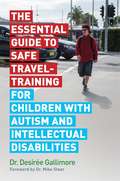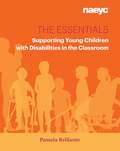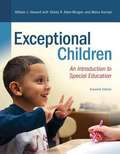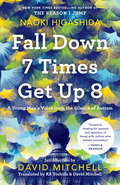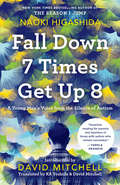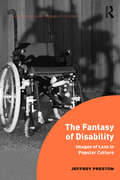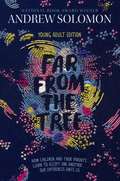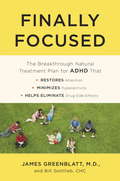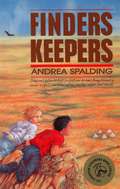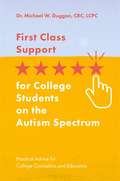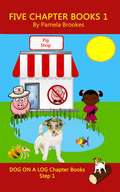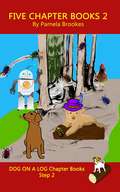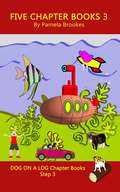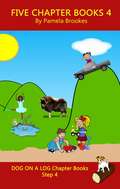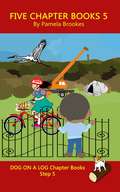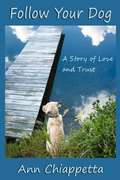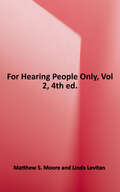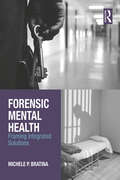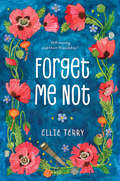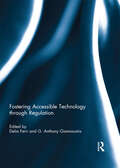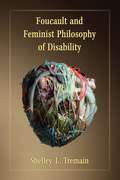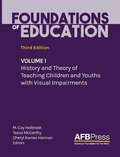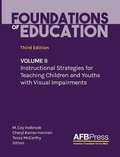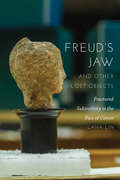Autism Spectrum Disorders: Foundations, Characteristics, and Effective Strategies
by E. Boutot Brenda MylesAutism Spectrum Disorders provides teachers of students with Autism Spectrum Disorder (ASD) or other developmental disabilities with important background information, historical context, etiological underpinnings, and characteristics of ASD that may impact learning. Written in an easy-to-follow format, the book focuses on evidence-based practices and approaches that have empirical bases for use. The book identifies current trends in research and practice and includes special Research, Diversity, and Trends and Issues boxes to clarify the concepts. Each chapter begins with real life scenarios depicting key information and concepts found in that chapter and include key terms, chapter objectives, end-of-chapter questions, and web resources to enhance learning and expand beyond the text. Significant changes to this edition include a chapter focusing on play, a chapter on motor development, and a chapter on sexuality. Updates and changes to the functional academics, functional life skills, environmental supports, and transition chapters add currency and further clarification to those topics. Throughout, the book focuses on real world practice that promotes lifespan success.
Backbone: Living with Chronic Pain without Turning into One
by Karen DuffyAn inspirational, powerful, and funny manual for coping and living with devastating pain. For two decades, Karen Duffy —New York Times bestselling author, former MTV VJ, Revlon model, and actress— has managed to live an enriching life despite living in a state of constant pain. Duffy has sarcoidosis, a disorder that causes the growth of inflammatory cells on different organs of the body. In her case, her sarcoidosis is located in her brain, causing her unimaginable pain. In this powerful, inspirational, funny, and important manual for surviving pain, Duffy draws on her experience as a patient advocate, certified recreational therapist, and hospital chaplain to illuminate gratifying methods people can use to cope with chronic pain and reinforces the sentiment that "circumstances determine our lives, but we shape our lives by what we make of circumstances" (Sir John Wheeler Bennet). More than one-third of the US population—nearly 113 million Americans—is currently living with chronic pain, while another 133 million Americans live with some form of chronic illness. Half of the US population lives with the challenges of these invisible illnesses where their symptoms are not always obvious to the casual observer. Addressing a country ravaged by both chronic pain and opioid addiction, Backbone offers a salve of self-sufficiency, spunk, and perseverance. With a light tone, deft wordplay, and interactive gems such as the Bill Murray Pain Scale, Mastectomy Paper Dolls, and a crown to wear just for getting out of bed, Duffy's serious—and seriously funny—book is for the massive population living with chronic pain who are eager to be understood and helped, and sends the message that despite the pain, there is a way to a good life.
Barriers and Belonging: Personal Narratives of Disability
by Alison Quaggin Harkin Leila Monaghan Michelle JarmanWhat is the direct impact that disability studies has on the lives of disabled people today? The editors and contributors to this essential anthology, Barriers and Belonging, provide thirty-seven personal narratives thatexplore what it means to be disabled and why the field of disability studies matters. The editors frame the volume by introducing foundational themes of disability studies. They provide a context of how institutions—including the family, schools, government, and disability peer organizations—shape and transform ideas about disability. They explore how disability informs personal identity, interpersonal and community relationships, and political commitments. In addition, there are heartfelt reflections on living with mobility disabilities, blindness, deafness, pain, autism, psychological disabilities, and other issues. Other essays articulate activist and pride orientations toward disability, demonstrating the importance of reframing traditional narratives of sorrow and medicalization. The critical, self-reflective essays in Barriers and Belonging provide unique insights into the range and complexity of disability experience.
Battle Born (Robbie & Sam)
by Caitlin RicciA Companion to the Robbie & Sam SeriesDaniel Messana wanted a way out of Thornwood, Colorado, and he found it in the Army. Now he’s returned with no more direction to his life than he had when he left as an angry teenager. And even though the war is behind him, the things he experienced won’t leave him in peace. His PTSD plagues him in crowds, and isolation sets in when he’s by himself. Because of the way he treated his brothers, regret gnaws at him, and he has no family to turn to. For Franklin “Coop” Cooper, the Army was life, and one he loved. But when an IED in Afghanistan left him blind, it ended not only the career he’d built, but any chance of being his own man. Back home, his parents refuse to let him do anything for himself, even though Coop and his service dog are ready to move forward and adjust to his new conditions. His only escape from being coddled like a child is going for pizza on base while his mother shops on Fridays. There, Daniel sits down next to him, and the two men begin a friendship that could become more—if they can break free from everything holding them back.
Beasts of Burden: Animal and Disability Liberation
by Sunaura TaylorA deeply provocative inquiry into the intersection of animal and disability liberation and the debut of an important new social critic How much of what we understand of ourselves as "human" depends on our physical and mental abilities how we move (or cannot move) in and interact with the world? And how much of our definition of "human" depends on its difference from "animal"? Drawing on her own experiences as a disabled person, a disability activist, and an animal advocate, author Sunaura Taylor persuades us to think deeply, and sometimes uncomfortably, about what divides the human from the animal, the disabled from the non-disabled and what it might mean to break down those divisions, to claim the animal and the vulnerable in ourselves, in a process she calls "cripping animal ethics." Beasts of Burden suggests that issues of disability and animal justice which have heretofore primarily been presented in opposition are in fact deeply entangled. Fusing philosophy, memoir, science, and the radical truths these disciplines can bring whether about factory farming, disability oppression, or our assumptions of human superiority over animals Taylor draws attention to new worlds of experience and empathy that can open up important avenues of solidarity across species and ability. Beasts of Burden is a wonderfully engaging and elegantly written work, both philosophical and personal, by a brilliant new voice.
Big and Small: A Cultural History of Extraordinary Bodies
by Lynne ValloneA groundbreaking work that explores human size as a distinctive cultural marker in Western thought Author, scholar, and editor Lynne Vallone has an international reputation in the field of child studies. In this analytical tour-de-force, she explores bodily size difference—particularly unusual bodies, big and small—as an overlooked yet crucial marker that informs human identity and culture. Exploring miniaturism, giganticism, obesity, and the lived experiences of actual big and small people, Vallone boldly addresses the uncomfortable implications of using physical measures to judge normalcy, goodness, gender identity, and beauty. This wide-ranging work surveys the lives and contexts of both real and imagined persons with extraordinary bodies from the seventeenth century to the present day through close examinations of art, literature, folklore, and cultural practices, as well as scientific and pseudo-scientific discourses. Generously illustrated and written in a lively and accessible style, Vallone’s provocative study encourages readers to look with care at extraordinary bodies and the cultures that created, depicted, loved, and dominated them.
Bioarchaeology of Impairment and Disability: Theoretical, Ethnohistorical, and Methodological Perspectives (Bioarchaeology and Social Theory)
by Jennifer F. Byrnes Jennifer L. MullerOver the years, impairment has been discussed in bioarchaeology, with some scholars providing carefully contextualized explanations for their causes and consequences. Such investigations typically take a case study approach and focus on the functional aspects of impairments. However, these interpretations are disconnected from disability theory discourse. Other social sciences and the humanities have far surpassed most of anthropology (with the exception of medical anthropology) in their integration of social theories of disability. This volume has three goals: The first goal of this edited volume is to present theoretical and methodological discussions on impairment and disability. The second goal of this volume is to emphasize the necessity of interdisciplinarity in discussions of impairment and disability within bioarchaeology. The third goal of the volume is to present various methodological approaches to quantifying impairment in skeletonized and mummified remains.
Bodies of Modernism: Physical Disability in Transatlantic Modernist Literature
by Maren LinettBodies of Modernism brings a new and exciting analytical lens to modernist literature, that of critical disability studies. The book offers new readings of canonical and noncanonical writers from both sides of the Atlantic including Flannery O'Connor, Eudora Welty, H. G. Wells, D. H. Lawrence, Elizabeth Bowen, Henry Green, Olive Moore, Carson McCullers, Tennessee Williams, J. M. Synge, Florence Barclay, Virginia Woolf, and James Joyce. Through readings of this wide range of texts and with chapters focusing on mobility impairments, deafness, blindness, and deformity, the study reveals both modernism's skepticism about and dependence on fantasies of whole, "normal" bodies.
A Boy Called Bat (The Bat Series #1)
by Charles Santoso Elana K. ArnoldFrom acclaimed author Elana K. Arnold and with illustrations by Charles Santoso, A Boy Called Bat is the first book in a funny, heartfelt, and irresistible young middle grade series starring an unforgettable young boy on the autism spectrum.For Bixby Alexander Tam (nicknamed Bat), life tends to be full of surprises—some of them good, some not so good. Today, though, is a good-surprise day. Bat’s mom, a veterinarian, has brought home a baby skunk, which she needs to take care of until she can hand him over to a wild-animal shelter.But the minute Bat meets the kit, he knows they belong together. And he’s got one month to show his mom that a baby skunk might just make a pretty terrific pet.
The Boy Who Loved Too Much: A True Story of Pathological Friendliness
by Jennifer LatsonThe poignant story of a boy’s coming-of-age complicated by Williams syndrome, a genetic disorder that makes people biologically incapable of distrust.What would it be like to see everyone as a friend? Twelve-year-old Eli D’Angelo has a genetic disorder that obliterates social inhibitions, making him irrepressibly friendly, indiscriminately trusting, and unconditionally loving toward everyone he meets. It also makes him enormously vulnerable. Eli lacks the innate skepticism that will help his peers navigate adolescence more safely—and vastly more successfully. Journalist Jennifer Latson follows Eli over three critical years of his life as his mother, Gayle, must decide whether to shield Eli entirely from the world and its dangers or give him the freedom to find his own way and become his own person. By intertwining Eli and Gayle’s story with the science and history of Williams syndrome, the book explores the genetic basis of behavior and the quirks of human nature. More than a case study of a rare disorder, however, The Boy Who Loved Too Much is a universal tale about the joys and struggles of raising a child, of growing up, and of being different.
Brilliant Imperfection: Grappling with Cure
by Eli ClareIn Brilliant Imperfection Eli Clare uses memoir, history, and critical analysis to explore cure—the deeply held belief that body-minds considered broken need to be fixed. Cure serves many purposes. It saves lives, manipulates lives, and prioritizes some lives over others. It provides comfort, makes profits, justifies violence, and promises resolution to body-mind loss. Clare grapples with this knot of contradictions, maintaining that neither an anti-cure politics nor a pro-cure worldview can account for the messy, complex relationships we have with our body-minds. The stories he tells range widely, stretching from disability stereotypes to weight loss surgery, gender transition to skin lightening creams. At each turn, Clare weaves race, disability, sexuality, class, and gender together, insisting on the nonnegotiable value of body-mind difference. Into this mix, he adds environmental politics, thinking about ecosystem loss and restoration as a way of delving more deeply into cure. Ultimately Brilliant Imperfection reveals cure to be an ideology grounded in the twin notions of normal and natural, slippery and powerful, necessary and damaging all at the same time.
Building Access: Universal Design and the Politics of Disability
by Aimi Hamraie“All too often,” wrote disabled architect Ronald Mace, “designers don’t take the needs of disabled and elderly people into account.” Building Access investigates twentieth-century strategies for designing the world with disability in mind. Commonly understood in terms of curb cuts, automatic doors, Braille signs, and flexible kitchens, Universal Design purported to create a built environment for everyone, not only the average citizen. But who counts as “everyone,” Aimi Hamraie asks, and how can designers know? Blending technoscience studies and design history with critical disability, race, and feminist theories, Building Access interrogates the historical, cultural, and theoretical contexts for these questions, offering a groundbreaking critical history of Universal Design. Hamraie reveals that the twentieth-century shift from “design for the average” to “design for all” took place through liberal political, economic, and scientific structures concerned with defining the disabled user and designing in its name. Tracing the co-evolution of accessible design for disabled veterans, a radical disability maker movement, disability rights law, and strategies for diversifying the architecture profession, Hamraie shows that Universal Design was not just an approach to creating new products or spaces, but also a sustained, understated activist movement challenging dominant understandings of disability in architecture, medicine, and society.Illustrated with a wealth of rare archival materials, Building Access brings together scientific, social, and political histories in what is not only the pioneering critical account of Universal Design but also a deep engagement with the politics of knowing, making, and belonging in twentieth-century United States.
Building on the Strengths of Students with Special Needs: How to Move Beyond Disability Labels in the Classroom
by Toby KartenAs a must-have reference for busy teachers with little special education training, this book supplies classroom-tested instructional strategies that address the characteristics of and challenges faced by students with special needs. Dozens of differentiated strategies target teachers’ anxieties and provide responsive interventions that can be used to address specifics of IEPs and learning plans. <p><p>With Building on the Strengths of Students with Special Needs, special education expert Toby Karten focuses on specific disabilities and inclusive curriculum scenarios for learners in K–12 environments. She offers valuable advice on how to prevent labels from capping student potential and encouragement to help teachers continually improve learner outcomes. <p><p>By highlighting more than a dozen disability labels, this resource walks teachers through the process of reinforcing, motivating, scaffolding, and planning for instruction that targets learners of all ability levels. Included are details relevant to each disability: <p>•Possible Causes <p>•Characteristics and Strengths <p>•Classroom Implications <p>•Inclusion Strategies <p><p>Typical instruction needs to match the diversity of atypical learners without viewing any disability as a barrier that impedes student achievement. Teachers must not only learn how to differentiate their approach and target specific student strengths but also maintain a positive attitude and belief that all students are capable of achieving self-efficacy.
Building Reasoning and Problem-Solving Skills in Children with Autism Spectrum Disorder: A Step by Step Guide to the Thinking In Speech® Intervention
by Janice NathanTeaching children with Autism Spectrum Disorder (ASD) to develop the 'inner voice' needed to solve problems, this book's innovative approach will help children reach logical and appropriate solutions to everyday problems. This book shows students and professionals how to formally teach key skills for reasoning and problem-solving that aren't usually explicitly taught, such as planning, pausing and reflecting and increasing emotional regulation. Focusing on the 'inner voice' - the dialogue that goes on inside our heads during every day routines - the authors explain how to help children with ASD solve problems independently. The book also shows how children can learn to cope with feelings of stress when confronted with difficult situations, whether getting stuck on homework, making mistakes, choosing options, following procedures that are perceived to be arbitrary, or everyday social situations. Examples of implementing this new approach in different situations are given to show the many ways of teaching these cognitive skills to children with autism.
But What Do I DO?: Strategies From A to W for Multi-Tier Systems of Support
by Catherine C. CollierIdentifying appropriate strategies for instruction or intervention made easy! Select individualized and evidence-based interventions for struggling students with this comprehensive guide. Organized around an alphabetized and cross-referenced list and a fold-out selection grid featuring more than 150 PBIS, RTI and MTSS interventions, you’ll quickly find the tools to resolve specific learning and behavioral challenges. You’ll learn to Meet the needs of all your struggling students including at-risk, culturally and linguistically diverse, as well as those with IEPs Progress monitor, document, and modify instructional strategies Identify specific interventions for distinct learning and behavior problems Implement in variety of settings, including special education, learning assistance programs, and full-inclusion
But What Do I DO?: Strategies From A to W for Multi-Tier Systems of Support
by Catherine C. CollierIdentifying appropriate strategies for instruction or intervention made easy! Select individualized and evidence-based interventions for struggling students with this comprehensive guide. Organized around an alphabetized and cross-referenced list and a fold-out selection grid featuring more than 150 PBIS, RTI and MTSS interventions, you’ll quickly find the tools to resolve specific learning and behavioral challenges. You’ll learn to Meet the needs of all your struggling students including at-risk, culturally and linguistically diverse, as well as those with IEPs Progress monitor, document, and modify instructional strategies Identify specific interventions for distinct learning and behavior problems Implement in variety of settings, including special education, learning assistance programs, and full-inclusion
But What If: But What If...; Mind Reading; Stuck On A Loop; Waht Is It? (Rollercoaster Series)
by Paula NagelThis is a focus on worries about transition to secondary school. Jake is in Year 6. He is worried about the transition to secondary school because he has heard many rumours, including one about the older pupils flushing first years' heads down the toilets. The story illustrates how many of the pupils share similar worries about the impending transition even though their behavior looks different. Jake's behaviour illustrates his initial negative coping strategies as his worry grows. This includes not talking about it, opting out of his usual interests and activities, not sleeping and becoming angry with his mother. Some of his worries are alleviated on his taster visit to the new school, especially when he plucks up the courage to go into the boys' toilets. Following a misunderstanding in the toilets with some older boys, he is able to share his worries with another pupil and use humour to reflect on his behaviour. The accompanying, 'Let's talk about .worry,' text shares information and facts about mental health and transition. Paul Nagel has worked as an educational psychologist for 17 years. This has included working as a Lead Professional Educational Psychologist managing a traded service, as well as holding Senior Specialist posts for early years and disability. Over the years Paula has worked in multi agency teams within paediatric services, youth offending teams, Sure Start and an anti bullying service. She is currently Principal Educational Psychologist (North) for the national children's mental health charity, Place2Be. Before qualifying as an Educational Psychologist Paula was a primary school teacher. Gary Bainbridge is an artist, comics creator and secondary school Art, Photography and Media Studies teacher from Durham. He's best known for the North East based kitchen sink superhero comic Sugar Glider and the Newcastle-set crime fiction comic, Nightbus. Gary teaches at an academy in Northumberland.
Cambridge Studies in Nineteenth-Century Literature and Culture: From Wordsworth to Gissing (Cambridge Studies in Nineteenth-Century Literature and Culture #109)
by Heather Tilley<P>In this innovative and important study, Heather Tilley examines the huge shifts that took place in the experience and conceptualisation of blindness during the nineteenth century, and demonstrates how new writing technologies for blind people had transformative effects on literary culture. <P>Considering the ways in which visually-impaired people used textual means to shape their own identities, the book argues that blindness was also a significant trope through which writers reflected on the act of crafting literary form. <P>Supported by an illuminating range of archival material (including unpublished letters from Wordsworth's circle, early ophthalmologic texts, embossed books, and autobiographies) this is a rich account of blind people's experience, and reveals the close, and often surprising personal engagement that canonical writers had with visual impairment. <P>Drawing on the insights of disability studies and cultural phenomenology, Tilley highlights the importance of attending to embodied experience in the production and consumption of texts.
Camped Out (Orca Currents)
by Daphne GreerMax knows his mom can't afford to send him to summer camp. But he really, really wants to go. He needs a break from looking after his autistic brother, Duncan. And from his mom's new boyfriend. He is surprised when his mom says that he can go after all. But there's a catch. There are spots available at the camp for families with special needs. A grant would cover Duncan's fees, and Max could attend at no charge. If he goes as Duncan's escort. This is the second story featuring Max and Duncan after Maxed Out.
Caring for Young Children with Special Needs
by Cindy CroftThis easy-to-use guide gives you a quick overview on many topics related to working with young children with special needs. Learn about inclusion in early childhood programs and disability law, as well as typical vs. atypical development. The quick guide also covers several specific disabilities/special needs and provides definitions, common characteristics, and practical strategies for adaptation.Cindy Croft is the director of the Center for Inclusive Child Care at Concordia University and on faculty for several university education programs. She has her MA in Education and has worked in the field of early childhood for over twenty years.
Case Studies in Adapted Physical Education: Empowering Critical Thinking
by Lauren Lieberman Martin Block Nathan Murata Samuel HodgeThe case studies in this book provide readers with opportunities to think critically about real-life situations that arise when working with children with varied abilities and disabilities, as well as opportunities to question and explore and to empower themselves in the process. The case scenarios illustrate actual experiences faced by a diverse group of general and adapted physical educators representing various contexts from self-contained APE classes and inclusive GPE (elementary, middle, and high school; urban, rural, and suburban) to youth sports, community recreation, and health club settings. When reading the book, pre-service and in-service teachers will be exposed to the issues facing physical educators as changes in federal law further mandate the inclusion of students with disabilities in general physical education classes and after-school sports. Identifying with the situations and characters in the cases will encourage readers to explore such issues as diversity and disability, attitude and ethics, behavior management and conflict resolution, and inclusion strategies. Questions following each case prompt readers to identify the critical issues and how the physical education professionals dealt with those issues, and then determine whether they would have handled the issues in the same way. Analyzing and discussing the cases will enable readers to formulate strategies for dealing with related issues and better prepare them to provide safe, satisfying, and successful physical activity experiences to individuals with varied abilities.
Chester and Gus
by Cammie McgovernCritically acclaimed author Cammie McGovern presents a heartwarming and humorous middle grade novel about the remarkable bond that forms between an aspiring service dog and an autistic boy in need of a friend. “Joyful, inspiring, and completely winning, Chester and Gus is unforgettable,” proclaimed Katherine Applegate, #1 New York Times bestselling author of the Newbery Medal winner The One and Only Ivan.Chester has always wanted to become a service dog. When he fails his certification test, though, it seems like that dream will never come true—until a family adopts him. They want him to be a companion for their ten-year-old son, Gus, who has autism. But Gus acts so differently than anyone Chester has ever met. He never wants to pet Chester, and sometimes he doesn’t even want Chester in the room. Chester’s not sure how to help Gus since this isn’t exactly the job he trained for—but he’s determined to figure it out. Because after all, Gus is now his person.In the spirit of beloved classics like Because of Winn-Dixie, Shiloh, and Old Yeller, Cammie McGovern’s heartfelt novel—told from Chester’s point of view—explores the extraordinary friendship between a child and a dog with a poignant and modern twist.
The Chicken Who Saved Us: The Remarkable Story of Andrew and Frightful
by Kristin Jarvis AdamsThe true story of an autistic boy with a body under siege by mysterious illness, and the chicken who saved his life."Heartbreakingly beautiful - the gift of the human animal bond.” - Temple Grandin, Author, researcher, consultant and world-renowned autism spokespersonEight-year-old Andrew was autistic and bilingual. He spoke English - and Chicken. But the day he told his pet chicken Frightful that his body was trying to kill him, Andrew’s family and an entire medical community were launched into a decade-long quest for answers. This honest memoir of fierce and faithful parenting takes readers on a heartfelt journey through chronic illness and Asperger’s syndrome to discover the healing bond between a boy and his chicken. Navigating the complex landscape of modern medicine and genetics, through a rare diagnosis of Trisomy 8 Mosaicism and an experimental bone marrow transplant, readers venture to places where chickens talk, superheroes come alive, and a boy on the brink of death finds the courage to survive.
Child Protection and Parents with a Learning Disability: Good Practice for Assessing and Working with Adults - including Autism Spectrum Disorders and Borderline Learning Disability
by Penny MorganChild Protection and Parents with a Learning Disability provides the practical knowledge that professionals need in order to understand common intellectual disabilities and how they might affect parenting capability. It presents clear guidance on how to carry out effective assessments and explains how interventions might differ when working with parents who have a learning disability. It covers a broad spectrum of disabilities, including borderline conditions and Autism Spectrum Disorder. The book also explores a number of emotional and mental health issues that can occur alongside learning disabilities, such as ADHD, anxiety, depression, and attachment disorders, to show how they should be understood in the context of cognitive abilities and the parenting role. Empowering practitioners to make informed decisions about children's welfare, this is a must-have guide for all professionals working with families where a parent is affected by a learning disability.
Coaching College Students with Executive Function Problems
by Mary R. Kennedy Mckay Moore SohlbergAlthough executive function difficulties are often addressed in school-age children, there are few resources showing how to help these individuals when they are older. This book presents a dynamic coaching model that helps college students become self-regulated learners by improving their goal-setting, planning, time management, and organizational skills. Ideal for use with students with attention-deficit/hyperactivity disorder (ADHD), learning disabilities, acquired brain injury, and other challenges, Mary R. T. Kennedy's approach incorporates motivational interviewing and emphasizes practical problem solving. User-friendly features include numerous concrete examples, sample dialogues, and print and online resource listings. In a large-size format for easy photocopying, the book contains 21 reproducible forms. Purchasers get access to a Web page where they can download and print the reproducible materials for repeated use.
Communicative Biocapitalism: The Voice of the Patient in Digital Health and the Health Humanities
by Olivia BannerThe Precision Medicine Initiative, Apple’s HealthKit, the FitBit—the booming digital health industry asserts that digital networks, tools, and the scientific endeavors they support will usher in a new era of medicine centered around “the voice of the patient.” But whose “voices” do such tools actually solicit? And through what perspective will those voices be heard? Digital health tools are marketed as neutral devices made to help users take responsibility for their health. Yet digital technologies are not neutral; they are developed from an existing set of assumptions about their potential users and contexts for use, and they reflect dominant ideologies of health, dis/ability, gender, and race. Using patient-networking websites, the Quantified Self, and online breast cancer narratives, Communicative Biocapitalism examines the cultural, technological, economic, and rhetorical logics that shape the “voice of the patient” in digital health to identify how cultural understandings and social locations of race, gender, and disability intertwine with whose voices are elicited and how they are interpreted.
Complete IEP Guide, The: How to Advocate for Your Special Ed Child
by Lawrence M. SiegelPut the law on your child's side Federal law guarantees every child a free, appropriate education, and the goal of the Individualized Education Program (IEP) is to assure that every child with special needs receives what the law promises. But if you have a special ed child, you know that your family must make sure the school follows through. This powerful book covers: eligibility rules and assessments working with outside experts developing your child's ideal educational program preparing for and attending IEP meetings develop a blueprint of program and services, and resolving disputes with school districts. Whether you're new to the IEP process or entering it once again, this user-friendly, plain English guide is your outline for an effective educational experience for your child. This edition of The Complete IEP Guide provides key forms, sample letters and resources you need at every stage of the IEP process. With it, you can make sure your child gets a good education—the education he or she deserves.
Contemplative Therapy for Clients on the Autism Spectrum: A Reflective Integration Therapy™ Manual for Psychotherapists and Counsellors
by Rachael Lee Harris Tony AttwoodDrawing on the ancient tradition of contemplation, Reflective Integration Therapy™ shows how mantra meditation and reflective therapy can be used with clients with high functioning autism. The Reflective Integration Therapy™ programme uses the cognitive differences in those with autism, such as their innate capacity for silence, withdrawal, intense focus and repetition as sources of therapeutic healing. This manual introduces this fresh, unique therapeutic approach, creating an essential resource for all practitioners working in the field of autism. All the material for twelve weekly sessions of therapy is included within the book.
Conversations with Interpreter Educators: Exploring Best Practices
by Christine MonikowskiSign language interpreter education is a relatively young field that is moving toward more theory-based and research-oriented approaches. The concept of sharing research, which is strongly encouraged in this academic community, inspired Christine Monikowski to develop a volume that collects and distills the best teaching practices of leading academics in the interpreting field. In Conversations with Interpreter Educators, Monikowski assembles a group of 17 professors in the field of sign language interpretation. Through individual interviews conducted via Skype, Monikowski engages them in informal conversations about their teaching experiences and the professional publications that have influenced their teaching philosophies. She guides each conversation by asking these experts to share a scholarly publication that they assign to their students. They discuss the merits of the text and its role in the classroom, which serves to highlight the varying goals each professor sets for students. The complexity of the interpreting task, self-reflection, critical thinking, linguistics, backchannel feedback, and cultural understanding are a sampling of topics explored in these exchanges. Engaging and accessible, Monikowski’s conversations offer evidence-based practices that will inform and inspire her fellow educators.
Creating Autism Champions: Autism Awareness Training for Key Stage 1 and 2
by Haitham Al-Ghani Joy BeaneyRaising awareness and understanding of autism has school-wide benefits, such as helping to improve the attitudes of pupils and staff and allowing children with autism to thrive socially, emotionally and educationally alongside their peers. This comprehensive resource provides a whole school programme for raising autism awareness and promoting inclusion. It includes training for staff in the knowledge and skills they need to support pupils, a sample school assembly, and lesson plans for teaching groups of pupils to be 'autism champions'. This programme also offers photocopiable worksheets and online presentations to use as part of the staff training, school assembly and peer awareness lessons. There is advice for involving children with autism and their parents in school activities. Easily adaptable for different age groups, this is a ready-made resource for schools committed to promoting autism awareness and whole school welfare.
Crip Times: Disability, Globalization, and Resistance (Crip #1)
by Robert McRuerContends that disability is a central but misunderstood element of global austerity politics. Broadly attentive to the political and economic shifts of the last several decades, Robert McRuer asks how disability activists, artists and social movements generate change and resist the dominant forms of globalization in an age of austerity, or “crip times.” Throughout Crip Times, McRuer considers how transnational queer disability theory and culture—activism, blogs, art, photography, literature, and performance—provide important and generative sites for both contesting austerity politics and imagining alternatives. The book engages various cultural flashpoints, including the spectacle surrounding the London 2012 Olympic and Paralympic Games; the murder trial of South African Paralympian Oscar Pistorius; the photography of Brazilian artist Livia Radwanski which documents the gentrification of Colonia Roma in Mexico City; the defiance of Chilean students demanding a free and accessible education for all; the sculpture and performance of UK artist Liz Crow; and the problematic rhetoric of “aspiration” dependent upon both able-bodied and disabled figurations that emerged in Thatcher’s England. Crip Times asserts that disabled people themselves are demanding that disability be central to our understanding of political economy and uneven development and suggests that, in some locations, their demand for disability justice is starting to register. Ultimately, McRuer argues that a politics of austerity will always generate the compulsion to fortify borders and to separate a narrowly defined “us” in need of protection from “them.”
Curative Violence: Rehabilitating Disability, Gender, and Sexuality in Modern Korea
by Eunjung KimIn Curative Violence Eunjung Kim examines what the social and material investment in curing illnesses and disabilities tells us about the relationship between disability and Korean nationalism. Kim uses the concept of curative violence to question the representation of cure as a universal good and to understand how nonmedical and medical cures come with violent effects that are not only symbolic but also physical. Writing disability theory in a transnational context, Kim tracks the shifts from the 1930s to the present in the ways that disabled bodies and narratives of cure have been represented in Korean folktales, novels, visual culture, media accounts, policies, and activism. Whether analyzing eugenics, the management of Hansen's disease, discourses on disabled people's sexuality, violence against disabled women, or rethinking the use of disabled people as a metaphor for life under Japanese colonial rule or under the U.S. military occupation, Kim shows how the possibility of life with disability that is free from violence depends on the creation of a space and time where cure is seen as a negotiation rather than a necessity.
Curricula for Students with Severe Disabilities: Narratives of Standards-Referenced Good Practice
by Phyllis JonesStudents with severe disabilities comprise 2 percent of the population of learners who are impacted by intellectual, communicative, social, emotional, physical, sensory and medical issues. Increasingly, however, teachers are required to meet the challenges of creating a pedagogical balance between an individual student's strengths, needs and preferences, and core academic curricula. The need to embrace the current initiative of curriculum state standards in the debate of curricula relevance, breadth, balance and depth for students with severe disabilities is not just timely—it contributes to the evolving debate of what constitutes an appropriate curriculum for severely disabled learners. Curricula for Students with Severe Disabilities supports the development of greater understandings of the role that state curriculum standards play in the pedagogical decision-making for students with severe intellectual disabilities. The book first discusses the nature and needs of these students, the curriculum for this group of learners and the recent contributions of state curriculum standards, before presenting narratives of real classrooms, teachers and students who have meaningfully integrated state curriculum standards at the kindergarten, elementary and high school levels.
Deaf in the USSR: Marginality, Community, and Soviet Identity, 1917-1991
by Claire L. ShawIn Deaf in the USSR, Claire L. Shaw asks what it meant to be deaf in a culture that was founded on a radically utopian, socialist view of human perfectibility. Shaw reveals how fundamental contradictions inherent in the Soviet revolutionary project were negotiated—both individually and collectively— by a vibrant and independent community of deaf people who engaged in complex ways with Soviet ideology.Deaf in the USSR engages with a wide range of sources from both deaf and hearing perspectives—archival sources, films and literature, personal memoirs, and journalism—to build a multilayered history of deafness. This book will appeal to scholars of Soviet history and disability studies as well as those in the international deaf community who are interested in their collective heritage. Deaf in the USSR will also enjoy a broad readership among those who are interested in deafness and disability as a key to more inclusive understandings of being human and of language, society, politics, and power.
Deaf People and Society: Psychological, Sociological and Educational Perspectives
by Irene W. Leigh Jean F. AndrewsDeaf People and Society incorporates multiple perspectives related to the topics of psychology, education, and sociology, including the viewpoints of deaf adults themselves. In doing so, it considers the implications of what it means to be deaf or hard of hearing and how deaf adults’ lives are impacted by decisions that professionals make, whether in the clinic, the school, or when working with family. This second edition has been thoroughly revised and offers current perspectives on the following topics:<P><P> * Etiologies of deafness and the identification process<P> * The role of auditory access<P> * Cognition, language, communication, and literacy<P> * Bilingual, bilingual/bimodal, and monolingual approaches to language learning<P> * Educational, legal, and placement aspects<P> * Childhood psychological issues<P> * Psychological and sociological viewpoints of deaf adults<P> * The criminal justice system and deaf people<P> * Psychodynamics of interaction between deaf and hearing people<P> Each chapter begins with a set of objectives and concludes with suggested readings for further research. This edition contains 10 new and original case studies, including ones on hearing children of deaf adults, sudden hearing loss, a young deaf adult with mental illness, and more. Written by a seasoned deaf/hearing bilingual team, this unique text continues to be the go-to resource for students and future professionals interested in working with deaf and hard-of-hearing persons.
Deaf to the Marrow: Deaf Social Organizing and Active Citizenship in Viet Nam
by Audrey C. CooperIn Deaf to the Marrow, public anthropologist Audrey C. Cooper examines the social production and transformation of ideas about language, bodies, and state-structured educational institutions in southern Viet Nam. Focusing on the reform period (1986 to the present), Cooper describes the ways that signed-language practices, ideologies, policies, and programming shape and are shaped by Deaf people’s social engagement in and around Ho Chí Minh City. Drawing on research data and work with Vietnamese Deaf colleagues covering an eight-year span, Cooper develops ethnographic and language-centered accounts of Deaf social organizing. These accounts illuminate the ways that Deaf citizens are assuming self-determining roles, or active citizenship, in decisions of local, national, and international importance. By placing Deaf social action in the historical context of state development and modernization projects, Cooper shows how educational structuring reflects dominant, spoken-language-centered views of Vietnamese Deaf people and signed languages. She also addresses the impact of international aid agendas on education, especially those related to disability. Deaf to the Marrow examines perspectives largely ignored in Deaf education, Deaf studies, signed-language linguistics, and anthropological literatures, thereby contributing to scholarship on language and sociopolitical formation broadly and the study of Deaf people’s citizenship practices specifically.
Developing Resilience in Young People with Autism using Social Stories™
by Siobhan TimminsYoung people with autism can be particularly susceptible to setbacks, often leading to depression and a sense of hopelessness. Using Social Stories™, this book introduces a different way of looking at common life setbacks, and offer tools to overcome these obstacles, build resilience and develop coping strategies for the future. Based on Carol Gray's highly effective Social Stories™ model, this new guide shows how to help individuals with autism deal with challenges specific to them, and how to bounce back from the negative experiences that they encounter. This book is an invaluable guide for learning to create personalised Social Stories™ that can be used to develop resilience in people with autism and help them to cope better with adversity.
Diary of a Beautiful Disaster
by Kristin BartzokisFeatures 8-page photo insert!“I highly recommend ‘Diary of a Beautiful Disaster’ as a journey through what it means to be a completely, and unflinchingly, beautiful human being.” - David Roche, humorist and author, “The Church of 80% Sincerity”She had just scored a perfect ten on her floor exercise routine, but Kristin Bartzokis stood stoically before the screaming crowd.For Kristin, this moment of perfection was something she always knew she could achieve. She’d been raised to live without limitations, and she’d adopted a determination to stay strong and unemotional, no matter what.Born with Treacher Collins Syndrome, a facial abnormality, Kristin learned at an early age the importance of strength–strength when confronted with multiple surgeries, strength when confronted with stares and questions, and strength when confronted with the constant knowledge that you will never look, or be, like everyone else.Kristin Bartzokis’ life story is one of achievement and inspiration, an example of an unbreakable spirit and unwavering fortitude. No matter what life has thrown at Kristin, she has turned challenges into triumphs and used obstacles as stepping stones.Diary of a Beautiful Disaster empowers readers to embrace their own uniqueness and boldly go forth into the world being exactly who they are. Kristin reminds us that although life can be complicated and messy, it is always, above all, beautiful.“ ‘Diary of a Beautiful Disaster’ is a moving memoir, but more than that it is an honest, sincere front-row peek into one woman’s ability to persevere, overcome, and find true acceptance.” – Erica Mossholder, executive director, Children’s Craniofacial Association
Digital Kids: How to Balance Screen Time, and Why it Matters
by Natalie Rosin Martin L. KutscherFor many children and teens daily Internet use is the norm - but where should we draw the line when it comes to digital media usage? This handy book lays out the essential information needed to understand and prevent excessive Internet use that negatively impacts behaviour, education, family life, and even physical health. Martin L. Kutscher, MD analyses neurological, psychological and educational research and draws on his own experience to show when Internet use stops being a good thing and starts to become excessive. He shows how to spot digital addictions, and offers whole family approaches for limiting the harmful effects of too much screen time, such as helping kids to learn to control their own Internet use. He tackles diverse questions ranging from the effects of laptops in the classroom and reading on a digital screen, to whether violent videogames lead to aggression. The author also explains how ADHD and Autism Spectrum Disorder (ASD) can make you more susceptible to Internet addiction, suggesting practical strategies to suit these specific needs. Discussing both the good and bad aspects of the internet, this book tells you everything you need to know to help children and young people use the internet in a healthy, balanced way.
Disabilities and the Disabled in the Roman World: A Social And Cultural History
by Christian LaesAlmost fifteen per cent of the world's population today experiences some form of mental or physical disability and society tries to accommodate their needs. But what was the situation in the Roman world? Was there a concept of disability? How were the disabled treated? How did they manage in their daily lives? What answers did medical doctors, philosophers and patristic writers give for their problems? <P><P>This book, the first monograph on the subject in English, explores the medical and material contexts for disability in the ancient world, and discusses the chances of survival for those who were born with a handicap. It covers the various sorts of disability: mental problems, blindness, deafness and deaf-muteness, speech impairment and mobility impairment, and includes discussions of famous instances of disability from the ancient world, such as the madness of Emperor Caligula, the stuttering of Emperor Claudius and the blindness of Homer.<P> The first scholarly study of the subject in English.<P> Comprehensively engages with literary sources, legal texts, epigraphy and papyrology, as well as with material evidence such as iconography.<P> Adopts an explicitly comparative approach which constantly seeks dialogue with new approaches and studies concerning other periods.
Disability and Equity in Higher Education Accessibility (Advances In Educational Marketing, Administration, And Leadership Ser.)
by Henry C. Alphin Jennie Lavine Roy Y. ChanEducation is the foundation of almost all successful lives. It is vital that learning opportunities are available on a global scale, regardless of individual disabilities or differences, and to create more inclusive educational practices. Disability and Equity in Higher Education Accessibility is a comprehensive reference source for the latest scholarly material on emerging methods and trends in disseminating knowledge in higher education, despite traditional hindrances. Featuring extensive coverage on relevant topics such as higher education policies, electronic resources, and inclusion barriers, this publication is ideally designed for educators, academics, students, and researchers interested in expanding their knowledge of disability-inclusive global education.
Disability and Masculinities
by Cassandra Loeser Vicki Crowley Barbara PiniIn recent years, attending to diversity in the cultivation of embodied identity has been given additional impetus as a result of intersectionality theory. Despite this, a key gap remains in terms of knowledge about masculinity and disability. This book addresses this lacuna through ten empirical chapters organised through the inter-related themes of corporeality, pedagogy and the critique of otherness. Each of the chapters positions the subject of masculinity and disability as a site of cultural pedagogy by affirming different ways of knowing of masculinity beyond dominant ideologies that normalise a particular masculine body and relegate disabled masculinities to the position of abnormal 'Other'. Part One focuses on pedagogy. Through the materialities of 'medicalized colonialism', imprimaturs of 'relational genealogies', 'compounding differences' and an analytical exposition of some of the neo-colonial conditions of the Global South within spatially-considered places of the Global North, Chapter 1 examines the denial of human rights to the Indigenous Anishinaabe community of Shoal Lake 40 in Canada. Chapter 1 theorises masculine corporeality in terms that take seriously First Nations', national and transnational body politics seriously. Chapter 2 examines the ways that movement and affect serve as a form of pedagogy for boys with autism spectrum in schools. Part Two's focus on corporeality includes an examination of the nexus of disability and diagnosis in the context of transgender men's experiences of mental health, and a discussion of the ways that intersex individuals who identify as men and have experienced 'genital normalising surgery' actively negotiate pluralised masculinities. The focus on media in Part Three encompasses a study of the mis-interpellation of the disabled male subject in Australian male literature, research on the discursive strategies utilised in media representations of disabled veterans in Turkey, and an analysis of the political implications of depictions of masculinity, disability and sexualities in a variety television program. Part Four's theme of self-stylisation takes up the questions of men's reconstructions of masculinity in light of Lyme Disease, the potential pleasures of heterosexuality for young men with a hearing disability in the realm of Australian-Rules Football, and the diverse ways that disabled men negotiate patriarchal masculinity in intimate relationships.
Disability and Rurality: Identity, Gender and Belonging (Interdisciplinary Disability Studies)
by Karen Soldatic Kelley JohnsonThis is the first book to explore how far disability challenges dominant understandings of rurality, identity, gender and belonging within the rural literature. The book focuses particularly on the ways disabled people give, and are given, meaning and value in relation to ethical rural considerations of place, physical strength, productivity and social reciprocity. A range of different perspectives to the issues of living rurally with a disability inform this work. It includes the lived experience of people with disabilities through the use of life history methodologies, rich qualitative accounts and theoretical perspectives. It goes beyond conventional notions of rurality, grounding its analysis in a range of disability spaces and places and including the work of disability sociologists, geographers, cultural theorists and policy analysts. This interdisciplinary focus reveals the contradictory and competing relations of rurality for disabled people and the resultant impacts and effects upon disabled people and their communities materially, discursively and symbolically. Of interest to all scholars of disability, rural studies, social work and welfare, this book provides a critical intervention into the growing scholarship of rurality that has bypassed the pivotal role of disability in understanding the lived experience of rural landscapes.
Disability and Social Media: Global Perspectives (500 Tips)
by Katie Ellis Mike KentSocial media is popularly seen as an important media for people with disability in terms of communication, exchange and activism. These sites potentially increase both employment and leisure opportunities for one of the most traditionally isolated groups in society. However, the offline inaccessible environment has, to a certain degree, been replicated online and particularly in social networking sites. Social media is becoming an increasingly important part of our lives yet the impact on people with disabilities has gone largely unscrutinised. Similarly, while social media and disability are often both observed through a focus on the Western, developed and English-speaking world, different global perspectives are often overlooked. This collection explores the opportunities and challenges social media represents for the social inclusion of people with disabilities from a variety of different global perspectives that include Africa, Arabia and Asia along with European, American and Australasian perspectives and experiences.
Disability, Human Rights, and Information Technology
by Jonathan Lazar Michael SteinDisability, Human Rights, and Information Technology addresses the global issue of equal access to information and communications technology (ICT) by persons with disabilities. The right to access the same digital content at the same time and at the same cost as people without disabilities is implicit in several human rights instruments and is featured prominently in Articles 9 and 21 of the Convention on the Rights of Persons with Disabilities. <P><P>The right to access ICT, moreover, invokes complementary civil and human rights issues: freedom of expression; freedom to information; political participation; civic engagement; inclusive education; the right to access the highest level of scientific and technological information; and participation in social and cultural opportunities. <P><P>Despite the ready availability and minimal cost of technology to enable people with disabilities to access ICT on an equal footing as consumers without disabilities, prevailing practice around the globe continues to result in their exclusion. Questions and complexities may also arise where technologies advance ahead of existing laws and policies, where legal norms are established but not yet implemented, or where legal rights are defined but clear technical implementations are not yet established. <P><P>At the intersection of human-computer interaction, disability rights, civil rights, human rights, international development, and public policy, the volume's contributors examine crucial yet underexplored areas, including technology access for people with cognitive impairments, public financing of information technology, accessibility and e-learning, and human rights and social inclusion. <P><P>Contributors: John Bertot, Peter Blanck, Judy Brewer, Joyram Chakraborty, Tim Elder, Jim Fruchterman, G. Anthony Giannoumis, Paul Jaeger, Sanjay Jain, Deborah Kaplan, Raja Kushalnagar, Jonathan Lazar, Fredric I. Lederer, Janet E. Lord, Ravi Malhotra, Jorge Manhique, Mirriam Nthenge, Joyojeet Pal, Megan A. Rusciano, David Sloan, Michael Ashley Stein, Brian Wentz, Marco Winckler, Mary J. Ziegler.
Disability in the Global South
by Shaun Grech Karen SoldaticThis first-of-its kind volume spans the breadth of disability research and practice specifically focusing on the global South. Established and emerging scholars alongside advocates adopt a critical and interdisciplinary stance to probe, challenge and shift common held social understandings of disability in established discourses, epistemologies and practices, including those in prominent areas such as global health, disability studies and international development. Motivated by decolonizing approaches, contributors carefully weave the lived and embodied experiences of disabled people, families and communities through contextual, cultural, spatial, racial, economic, identity and geopolitical complexities and heterogeneities. Dispatches from Ghana, Lebanon, Sri Lanka, Cambodia, Venezuela among many others spotlight the complex uncertainties of modern geopolitics of coloniality; emergent forms of governance including neoliberal globalization, war and conflicts; the interstices of gender, race, ethnicity, space and religion; structural barriers to redistribution and realization of rights; and processes of disability representation. This handbook examines in rigorous depth, established practices and discourses in disability including those on development, rights, policies and practices, opening a space for critical debate on hegemonic and often unquestioned terrains. Highlights of the coverage include: Critical issues in conceptualizing disability across cultures The challenges of disability statistics. Colonialism and disability Disability and poverty: critical renegotiations Livelihoods and disability: the complexities of labouring in the global South. Intersectional terrains, including migration, race, ethnicity, and customary embodiedness Disability and Religion Violence against disabled women in the global South: working locally, acting globally. Disability-inclusive disaster risk reduction The UNCRPD and critical orientations towards disability rights within various contextual settings Redistribution systems including disability inclusive budgeting, social security regimes and social policy measures Global South-North partnerships: intercultural methodologies in disability research. This much awaited handbook provides students, academics, practitioners and policymakers with an authoritative framework for critical thinking and debate about disability, while pushing theoretical and practical frontiers in unprecedented ways.
Disability, Intimacy, and Sexual Health: A Social Work Perspective
by Kristen Faye Linton Heidi Adams Rueda Lela Rankin Williams"Sexuality is a key aspect of human development and identity, yet people with disabilities frequently encounter social and political barriers to achieving healthy, autonomous intimate relationships. Society tends to associate disability with asexuality and often labels sexual behaviors among people with disabilities as problematic or deviant. Faced with these assumptions and resultant policies, how can social workers meet the needs of this diverse population across the life course? In this book, Linton, Adams Rueda, and Rankin Williams compile comprehensive research and candid interviews with social workers to explore the complicated intersection of disability and sexuality. The book begins by detailing historical violations of the sexual and reproductive rights of people with disabilities, including forced castration and sterilization. It then explores current issues of sexuality and disability throughout the life course, starting with childhood and adolescence. The authors examine the increased risk of abuse and victimization that people with disabilities face while in romantic or sexual relationships and provide practice recommendations to help combat factors that contribute to this vulnerability. Other milestones across the life course are also explored, such as pregnancy and parenting, marriage and cohabitation, and intimacy in older adulthood. Throughout the book, the authors examine the micro, meso, and macro systems that affect the lives and relationships of people with disabilities. This book touches on psychiatric, intellectual, developmental, learning, neurological, and physical disabilities and gives voice to both practitioners and their clients. It's an unflinching look at the pressing challenges professionals can face while serving people with disabilities, essential for students, academics, policymakers, and practitioners in a variety of settings who wish to advocate for the full sexual citizenship of people with disabilities"--The publisher.
Disability Law: Cases And Materials (American Casebook Series)
by Stephen Befort Nicole PorterThis casebook covers disability discrimination under the Americans with Disabilities Act and special education under the Individuals with Disabilities Education Act. It includes statutory text and court decisions in the areas of employment, government services, public accommodations, and education. The casebook incorporates a substantial number of cases decided after the enactment of the ADA Amendments Act. This casebook has a greater focus on employment issues than other casebooks and could support either a stand-alone disability discrimination in employment course or a broad-based disability law course. Each chapter contains streamlined notes and questions designed to provoke thoughtful class discussion.
Disability Media Studies
by Elizabeth Ellcessor and Bill KirkpatrickIntroduces key ideas and offers a sense of the new frontiers and questions in the emerging field of disability media studies Disability Media Studies articulates the formation of a new field of study, based in the rich traditions of media, cultural, and disability studies. Necessarily interdisciplinary and diverse, this collection weaves together work from scholars from a variety of disciplinary homes, into a broader conversation about exploring media artifacts in relation to disability. The book provides a comprehensive overview for anyone interested in the study of disability and media today. Case studies include familiar contemporary examples—such as Iron Man 3, Lady Gaga, and Oscar Pistorius—as well as historical media, independent disability media, reality television, and media technologies. The contributors consider disability representation, the role of media in forming cultural assumptions about ability, the construction of disability via media technologies, and how disabled audiences respond to particular media artifacts. The volume concludes with afterwords from two different perspectives on the field—one by disability scholar Rachel Adams, the other by media scholars Mara Mills and Jonathan Sterne—that reflect upon the collection, the ongoing conversations, and the future of disability media studies. Disability Media Studies is a crucial text for those interested in this flourishing field, and will pave the way for a greater understanding of disability media studies and its critical concepts and conversations.
Disability Politics in a Global Economy: Essays in Honour of Marta Russell
by Ravi MalhotraWhile the visibility of disability studies has increased in recent years, few have thoroughly examined the marginalization of people with disabilities through the lens of political economy. This was the great contribution of Marta Russell (1951-2013), an activist and prominent scholar in the United States and best known for her analyses of the issues faced by people with disabilities. This book examines the legacy of Marta Russell, bringing together distinguished scholars and activists such as Anne Finger, Nirmala Erevelles and Mark Weber, to explicate current issues relevant to the empowerment of people with disabilities. Drawing from various fields including Law, Political Economy, Education and History, the book takes a truly interdisciplinary approach, offering a body of work that develops a dextrous understanding of the marginalization of people with disabilities. The book will be of great use and interest to specialists and students in the fields of Political Economy, Law and Society, Labour Studies, Disability Studies, Women’s Studies, and Political Science.
Disability Rights Advocacy Online: Voice, Empowerment and Global Connectivity (Routledge Studies in Global Information, Politics and Society)
by Filippo TrevisanDisability rights advocates in the United Kingdom and the United States recently embraced new media technologies in unexpected and innovative ways. This book sheds light on this process of renewal and asks whether the digitalisation of disability rights advocacy can help re-configure political participation into a more inclusive experience for disabled Internet users, enhancing their stakes in democratic citizenship.
Disability, Society and Assistive Technology (Interdisciplinary Disability Studies)
by Bodil Ravneberg Sylvia SöderströmThe provision of assistive technology is an important individual and collective service of the welfare state. The state plays a significant role towards linking users and products, and the matching of devices and users is both a science and an art. However, many people feel it is stigmatising to use individually designed assistive technologies as they often, in a subtle way, convey discriminating barriers in society. The major challenges of assistive technology are thus to reduce social exclusion and marginalisation and, importantly, to reduce individual risks and societal costs related to non-use due to deficiencies in usability, aesthetics and design of the technologies. This groundbreaking book discusses the relationships among society, disability and technology by using different empirical examples (e.g., school, everyday life) to show why the combination of disability studies and STS-studies (science, technology and society) is a fruitful approach to understanding and meeting these challenges. The book explores the significance of the technologies for users, society and the field; identifies challenges to designing, adopting and using assistive technologies; and points at theoretical challenges in research as well as professional challenges in assistive technology service provision. The book also scrutinises the role of assistive technology devices, as well as the organisational structure of the assistive technology market, in relation to disabled people’s lives. This book will be valuable reading for students, academics, teachers and social educators interested in Disability Studies, STS Studies, Product Design, Sociology, Occupational Therapy and Physiotherapy, as well as engineers working in the field of assistive technology.
Disability Studies and the Environmental Humanities: Toward an Eco-Crip Theory
by Sarah Jaquette Ray Jay Sibara Stacy AlaimoAlthough scholars in the environmental humanities have been exploring the dichotomy between “wild” and “built” environments for several years, few have focused on the field of disability studies, a discipline that enlists the contingency between environments and bodies as a foundation of its scholarship. On the other hand, scholars in disability studies have demonstrated the ways in which the built environment privileges some bodies and minds over others, yet they have rarely examined the ways in which toxic environments engender chronic illness and disability or how environmental illnesses disrupt dominant paradigms for scrutinizing “disability.” Designed as a reader for undergraduate and graduate courses, Disability Studies and the Environmental Humanities employs interdisciplinary perspectives to examine such issues as slow violence, imperialism, race, toxicity, eco-sickness, the body in environmental justice, ableism, and other topics. With a historical scope spanning the seventeenth century to the present, this collection not only presents the foundational documents informing this intersection of fields but also showcases the most current work, making it an indispensable reference.
Disability Studies and the Inclusive Classroom: Critical Practices for Embracing Diversity in Education
by Susan BaglieriDisability Studies and the Inclusive Classroom is a core textbook that integrates knowledge and practice from the fields of disability studies and special education. The second edition has been fully revised and updated throughout to include stronger connections between race, class, sexual orientation, gender, and disability to emphasize intersecting identities and experiences; stronger emphasis on curriculum and teaching rather than on attitudes toward disability; and updates to current events, cultural references, resources, research literature, laws, and policies.
The Disability Studies Reader
by Lennard J. DavisThe fifth edition of The Disability Studies Reader addresses the post-identity theoretical landscape by emphasizing questions of interdependency and independence, the human-animal relationship, and issues around the construction or materiality of gender, the body, and sexuality. Selections explore the underlying biases of medical and scientific experiments and explode the binary of the sound and the diseased mind. The collection addresses physical disabilities, but as always investigates issues around pain, mental disability, and invisible disabilities as well. Featuring a new generation of scholars who are dealing with the most current issues, the fifth edition continues the Reader’s tradition of remaining timely, urgent, and critical.
Disruptive, Stubborn, Out of Control?: Why kids get confrontational in the classroom, and what to do about it
by Bo Hejlskov ElvénOne of the biggest challenges in the classroom is trying to teach when students act in unexpected and annoying ways. Based on the psychology of how children and people act, this book offers practical strategies for understanding why your students are behaving in the way they are, and how to react in a way that restores peace and harmony in the classroom. With many examples of typical confrontational behaviours and clues for how to understand and resolve the underlying issues, this book will be every stressed teacher's best friend.
Dog Diaries #10: Rolf
by Kate Klimo Tim JessellA dachshund loses a leg and finds his life's calling—as a therapy dog! Scrappy dachshund Rolf von Noodle may be missing a hind leg, but he's got attitude and can-do spirit to spare! If anything, his tripod status gives him something special: real empathy for people overcoming physical challenges. And as his owner Mindy discovers, it makes him an ideal choice to become a therapy dog. With realistic black-and-white illustrations and an appendix that includes photographs and information about the American Kennel Club's Canine Good Citizen program, therapy dog training, tripod dogs, and more, this is the kind of fact-based fiction reluctant middle grade readers sit up and beg for!
Dogs With Jobs: Inspirational Tales of the Worlds Hardest-Working Dogs
by Laura GreavesMeet Molly Polly, the diabetes alert dog whose round-the-clock job is to keep her two young owners healthy; Bailey, the Assistant Director of Seagulls, who keeps the pesky birds away from the heritage vessels at the Australian National Maritime Museum; and Daisy, the Collie mix who's a full-time guide dog for another dog. From inspirational moments of bravery to dogs doing the jobs that no one else can, these are the life-affirming stories of the most remarkable dogs on the planet.
Dream Shot: The Journey to a Wheelchair Basketball National Championship
by Josh Birnbaum Matthew E. BuchiIn 2008, the men's wheelchair basketball team at the University of Illinois set out to achieve their sport's pinnacle: a college national championship. That lofty goal represented another stage of a journey begun in 1948 when Tim Nugent established the Gizz Kids wheelchair squad. Embedded with the team, Josh Birnbaum took photos that captured the life experiences of people in the Illinois wheelchair basketball program from 2005 through the 2008 championship season. Dream Shot follows the unique lives of the players and coaches on the court and the road, and in quiet moments at home and the classroom. Along the way, Birnbaum provides the definitive story of the 2008 team and the challenges it overcame to capture one of Illinois's record fifteen men's titles. Featuring more than 100 color photographs, Dream Shot memorializes a legendary team alongside the story of the university's dedication to the progress of disability rights.
The Duke of Bannerman Prep
by Katie A. NelsonWords are weapons. Facts can be manipulated. And nothing is absolute-especially right and wrong.Tanner McKay is at Bannerman Prep for one reason: to win. The elite school recruited him after he argued his public school's debate team to victory last year, and now Bannerman wants that championship trophy. Debate is Tanner's life-his ticket out of scrimping and saving and family drama, straight to a scholarship to Stanford and a new, better future.When he's paired with the prep school playboy everyone calls the Duke, Tanner's straightforward plans seem as if they're going off the rails. The Duke is Bannerman royalty, beloved for his laissez-faire attitude, crazy parties, and the strings he so easily pulls. And a total no-show when it comes to putting in the work to win.As Tanner gets sucked into the Duke’s flashy world, the thrill of the high life and the adrenaline of the edge becomes addictive. A small favor here and there seems like nothing in exchange for getting everything he ever dreamed of.But the Duke’s castle is built on shady, shaky secrets, and the walls are about to topple.A contemporary retelling of The Great Gatsby, Katie A. Nelson’s taut debut is perfect for anyone who's struggled to survive the cutthroat world of competitive high school.
The Dyscalculia Toolkit: Supporting Learning Difficulties in Maths
by Ronit BirdThe new edition of the bestselling Dyscalculia Toolkit continues to meet the needs of specialist and non-specialist teachers working with learners aged 6 to 14 years, who have difficulty with maths and number. Now with over 200 activities and 50 games, new and improved illustrations, and an expanded list of recommended readings, useful websites & resources, the new edition also includes exclusive access to a brand new companion website which features; - 10 videos with over 45 minutes of material demonstrating a selection of games from every section - Editable pupil tracking sheets organised by teaching point and section - Over 70 pages of downloadable and printable teaching materials including activity sheets, game boards, teaching resources & summary tables. Packed full of practical, creative and innovative ideas and strategies this is the complete toolkit to help teachers and parents support learners with dyscalculia or those struggling with mathematics.
The Dyscalculia Toolkit: Supporting Learning Difficulties in Maths
by Ronit BirdThe new edition of the bestselling Dyscalculia Toolkit continues to meet the needs of specialist and non-specialist teachers working with learners aged 6 to 14 years, who have difficulty with maths and number. Now with over 200 activities and 50 games, new and improved illustrations, and an expanded list of recommended readings, useful websites & resources, the new edition also includes exclusive access to a brand new companion website which features; - 10 videos with over 45 minutes of material demonstrating a selection of games from every section - Editable pupil tracking sheets organised by teaching point and section - Over 70 pages of downloadable and printable teaching materials including activity sheets, game boards, teaching resources & summary tables. Packed full of practical, creative and innovative ideas and strategies this is the complete toolkit to help teachers and parents support learners with dyscalculia or those struggling with mathematics.
Dyslexia in the Early Years: A Handbook for Practice
by Gavin ReidResearch has shown that early identification and intervention is crucial and can in fact minimise, and may even prevent, the challenges of dyslexia from becoming too detrimental at later stages of education. This book offers both research insights and practical guidance for teachers working in Early Years settings on how to create resource materials that would be suitable for the development of children with dyslexia. Beginning with a contextual note on the key difficulties faced by children at risk of dyslexia, the book takes the reader through the processes of identification and diagnosis, before offering ideas on how to tailor classroom materials for these students. The book's resource materials are designed to target areas such as reading, spelling, numeracy, language skills, social and emotional development, and problem solving skills.
Dyslexia is My Superpower (Most of the Time)
by Margaret RookeIn more than 100 interviews, children and young adults reveal their personal tips and tactics for honing the creative benefits of dyslexia, enabling them to thrive in school and beyond. Strategies include ways to develop confidence and self-belief. The contributors have outlined specific approaches they feel have helped them, and others that haven't. The book contains stunning illustrations by 8-18 year olds with dyslexia.The first-hand accounts are inspiring in the way they normalise dyslexia and reveal the many success stories. There is an additional section for professionals who work in education or special learning environments, with advice given by school students themselves.
The Ear Book: A Complete Guide to Ear Disorders and Health (A Johns Hopkins Press Health)
by Thomas J. Balkany Kevin D. Brown“Everything you ever wanted to know about ears from two outstanding physician scientists. I loved this book!” —Donna Shalala, Former U.S. Secretary of Health and Human ServicesIn The Ear Book, Drs. Thomas J. Balkany and Kevin D. Brown, recognized experts on ears and hearing, explain how the anatomy of the ear facilitates hearing and balance and then examine the causes, symptoms, and treatment of common problems of the outer, middle, and inner ear. Their explanations take the mystery out of hearing aids, the proper care of ears, and how the pressurized conditions of scuba diving and air travel affect the ears. And they debunk ear-related myths—from the notion that exposure to loud noise strengthens the ear to the idea that tinnitus can be cured with nutrients—and urge readers to stop using ear candling or Q-tips to get rid of wax.Drs. Balkany and Brown address such common questions as: Can dizziness be cured? How loud is too loud? Why do my ears ring? Do cochlear implants work for nerve deafness? What promise do innovations in gene therapy and stem cell therapy hold for the future? Fully illustrated and including helpful tables, hearing preservation tips, a glossary of terms, lists of ear medications and resources, and suggestions for further reading, The Ear Book is sure to be a welcome family guide.“This book is gem for everyone with questions about their ears. I highly recommend it—especially the chapter on Myths of the Ear!” —D. Bradley Welling, MD, PhD, Harvard University Department of Otolaryngology
Early Childhood Intervention: Working with Families of Young Children with Special Needs (Evolving Families)
by Hanan Sukkar Carl J. Dunst Jane KirkbyEarly childhood is considered a critical but often vulnerable period in a child’s development where early identification and intervention can be crucial for improving children’s developmental outcomes. Systems and family-centred perspectives are vital to support families and build their capacities to lead normalized lives with improved family quality of life. This book explores the family-centred practices and systems factors which influence families’ experiences raising children with complex needs. It also considers the ways in which professionals can work with families to build and support parent and child competence. Conceptual and practical work from Australia, Canada, Europe and the United States present descriptions of and implications for different family system frameworks and early-childhood programs. Contributors in this edited volume bring together contemporary information that bridges the research to practice gap in supporting families of young children with disabilities or delays. Chapters include: Early Intervention for Young Children with Developmental Delays: Contributions of the Developmental Systems Approach Family Composition and Family Needs in Australia: What Makes a Family? Working with Families in Early Childhood Intervention: Family-Centred Practices in an Individualised Funding Landscape Family Systems and Family-Centred Intervention Practices in Portugal and Spain: Iberian Reflections on Early Childhood Intervention This book will attract the attention scholars of Parenting and Families; Child Development and Childcare.
Early Intervention for Reading Difficulties: The Interactive Strategies Approach
by Donna Scanlon Kimberly Anderson Joan SweeneyGrounded in a strong evidence base, this indispensable practitioner guide and text has given thousands of teachers tools to support the literacy growth of beginning and struggling readers in grades K-2. The interactive strategies approach (ISA) is organized around core instructional goals related to enhancing word learning and comprehension of text. The book provides guidance for assessment and instruction in whole-class, small-group, and one-to-one settings, using the curricular materials teachers already have.
EBUNDLE: What Really Works With Exceptional Learners + Distance Learning Supplement
by Wendy Weichel Murawski Kathy Lynn Gandhi Amy I. GainesAuthors Wendy Murawski and Amy Gaines have created this supplement to the bestselling What Really Works With Exceptional Learners to respond to the need for information on best practices for students with special needs in distance, hybrid, and remote learning settings. Packed with practical strategies, research, and tried-and-true advice, this supplement provides educators with resources that will help their students not only learn, but also thrive. This supplement offers current research related to topic such as inclusive practices, specially designed instruction (SDI), social-emotional learning, teacher burnout, UDL, collaborating with co-teachers, and communicating with parents. The authors then highlight actions to avoid and actions to embrace. Call-out boxes identify key concepts, ways to implement technology, and where to find additional information in other chapters of What Really Works with Exceptional Learners. Tables and templates help readers quickly learn and utilize additional strategies. Additional resources and references are also offered for those who would like to go deeper.
Educating Special Students: An introduction to provision for learners with disabilities and disorders
by Michael FarrellEducating Special Students is the definitive guide to evidence based practice and professionally informed approaches to provision for special students. Now in its third edition, the book sets out ideas of best practice relating to different disabilities and disorders, helpfully discussing what might constitute effective provision. This edition has been updated to take account of new ways of classifying disabilities and disorders, and recent developments in research and practice, including the 2014 SEND Code of Practice (England) and the Diagnostic and Statistical Manual of Mental Disorders Fifth Edition DSM-5TM. A new appendix provides information on basic anatomy and physiology. International in scope, the book explores issues relating to: intellectual disability (profound, moderate to severe, and mild) sensory impairments orthopaedic impairment and motor disorders, health impairments, and traumatic brain injury oppositional defiant disorder, conduct disorder, anxiety disorders, depressive disorders, and attention deficit hyperactivity disorder communication disorders (speech, grammar and comprehension, semantics and pragmatics), and autism spectrum disorder specific learning disorders with impairment in reading, written expression and mathematics, and developmental co-ordination disorder. Educating Special Students will be of interest to all those studying special education, professionals, and others committed to seeking the best provision for special students.
Educating Students With Severe And Multiple Disabilities: A Collaborative Approach
by Fred P. Orelove Dick Sobsey Donna GillesA cornerstone of special education training for 30 years, this is the definitive textbook for preparing educators, counselors, and other related services professionals to teach children with severe and multiple disabilities in inclusive settings. Now in a revised, thoroughly updated, and streamlined fifth edition, this bestselling volume gives current and future educators the research and practical strategies they need to ensure the best learning outcomes for their students. Presenting a team-based, collaborative approach to education, this comprehensive text includes valuable contributions from respected experts in diverse fields, including fresh voices in special education, physical therapy, occupational therapy, communication, counseling, and pediatrics. Equally useful for preservice professionals and practicing educators in inclusive classrooms, this highly regarded textbook will fully prepare professionals to meet the educational, emotional, and health care needs of students with severe and multiple disabilities.
Effective School Interventions: Evidence-Based Strategies for Improving Student Outcomes
by Matthew K. Burns T. Chris Riley-Tillman Natalie RathvonThis indispensable course text and practitioner resource, now fully revised, has helped tens of thousands of readers implement evidence-based interventions to improve students' academic achievement and behavior in PreK–12. The volume presents best-practice guidelines and step-by-step procedures for 83 interventions that can easily be implemented by teachers and other school-based professionals. It is a go-to book for those working in a multi-tiered system of support (MTSS) or response-to-intervention (RTI) framework. User-friendly features include recommended print and online resources and 10 reproducible forms. Purchasers get access to a webpage where they can download and print the reproducible materials in a convenient 8 1/2" x 11" size. New to This Edition: *Updated throughout to reflect current research-based best practices. *20 new interventions. *Chapter on important skills for intervention success. *The intensity of each intervention (classwide, small-group, and/or individual) is now specified. *Behavior chapter has been reorganized for easier use. *Downloadable reproducible tools.
Emotional and Behavioral Problems of Young Children, Second Edition: Effective Interventions in the Preschool and Kindergarten Years
by Gretchen Gimpel Peacock Jessica Malmberg Melissa L. HollandPresenting interventions that are practical, effective, and easy to implement in educational and clinical settings, this book addresses the most frequently encountered emotional and behavioral problems in 3- to 6-year-olds. Strategies for collaborating with parents are emphasized. Practitioners are taken step by step through assessing and treating conduct problems, anxiety and other internalizing problems, toileting difficulties, picky eating and related concerns, and sleep problems. User-friendly features include 36 reproducible parent handouts, assessment forms, and other clinical tools; the print book has a large-size format with lay-flat binding for easy photocopying. Purchasers get access to a Web page where they can download and print the reproducible materials. This book is in The Guilford Practical Intervention in the Schools Series. New to This Edition *Reflects over a decade of research advances, plus new assessments and interventions. *Updated for DSM-5. *Chapter on intervention within a multi-tiered system of support (MTSS). *Chapter on referral procedures for complex problems. *Mindfulness techniques for both parents and children. *Cutting-edge ways to use acceptance and commitment therapy principles and motivational interviewing with parents. *23 new or revised reproducible tools.
The Emotional Compass: How to Think Better about Your Feelings
by Ilse Sand'Feelings are something we have, not something we are.' Revealing the complexity of emotions such as happiness, anger, fear, and jealousy, and how these are based on our perception of other people, Ilse Sand offers her professional wisdom on the psychology of feelings. Establishing that emotions are not always as appropriate as they first appear to be, the book encourages you to take a closer look at why you are feeling certain things, and how you can change how you feel. Especially written for highly sensitive people, guidance is included on how to identify the vulnerable feelings that often underlie our more volatile emotional states, and practical activities are suggested to help to embrace or reject sadness, delay impulsive actions, and allow yourself to be happy. Drawing on real-life examples throughout, the book offers you the means to improve your understanding of not only your own emotions and emotional actions, but those of others. The book will be immensely useful not only to people who feel things strongly, but to those who have trouble understanding or interpreting emotions and how to respond to the feelings they provoke.
Empowering Parents of Children with Autism Spectrum Disorder
by Amanda Webster Joy Cumming Susannah RowlandThis book presents an international research-based framework that has empowered parents of children with autism spectrum disorder (ASD) to become critical decision makers to actively guide their child's learning and self-advocacy. Parents can use this framework to identify their child's vision and dreams, and to work with educators and service providers to establish specific learning goals and to implement effective interventions and programs that enable their child to achieve those goals and realise their vision for the future. The book begins by reviewing available research on evidence-based practice for children with ASD and outlining the Cycle of Learning decision-making framework for parents and professionals. Throughout the remainder of the book, case studies are presented to illustrate the ways in which different parents have successfully utilised this framework to develop effective plans for their child and to advocate for learning and education programs for both their child and other children with ASD in school and community settings. In addition, it highlights concrete examples of how parents have used the framework to empower their children with ASD to develop their self-awareness and self-determination, and to be able to self-advocate as they move through adolescence and into adult life.
Epilepsy and Intellectual Disabilities
by Vee P. Prasher Mike KerrThis second edition of a successful book provides updated clinical and research knowledge, including information on the licensing of new antiepileptic drugs. All chapters are updated to reflect present accepted practice. New chapters highlighting the importance of the genetic aspects of epilepsy, nonpharmacological treatments, and the impact of epilepsy on families and carers have been added. Ongoing developments in the general population, which will more likely than not become relevant to the intellectually disabled population, are discussed. The impact of epilepsy on the person themselves and their carers is acknowledged, and person-centred treatment programs with a multifaceted team approach are proposed. This book is aimed at physicians and residents in neurology and pediatrics, as well as other practitioners working with this population, such as neuropsychologists. Epilepsy and Intellectual Disabilities, Second Edition is recommended reading for all those caring for this important group of individuals.
The Essential Guide to Safe Travel-Training for Children with Autism and Intellectual Disabilities
by Martha D'Avigdor Lizzie D'Avigdor Dr Mike Steer Dr Dr Desirée GallimoreFor those growing up with an intellectual disability or autism, comfortable, safe and independent travel will prove an invaluable life skill. The key to pursuing fulfilling work and leisure activities and developing as an individual, it also brings a liberating level of self-sufficiency and reassurance of equality within society. Arriving at this goal can be daunting. Dr Gallimore's straightforward five-step system will guide parents and professionals through successful training for children of any age and ability. Focusing on understanding each child's individual goals and challenges, it gives you the 'ingredients' needed to fully prepare for each journey in advance, and shows how to judge when to step back and let the child progress alone. Addressing specific fears and obstacles that make travel difficult for children with learning difficulties, it sets out all the precautions necessary to safeguard children and others as they learn to reach their chosen destinations. Clear-cut and far-reaching, this book is enriched by Dr Gallimore's extensive experience as a psychologist, mobility specialist and travel-trainer. It is a heartening resource and will be necessary reading for anyone working with a child to get them on their path to independent travel.
The Essentials: Supporting Young Children with Disabilities in the Classroom (The Essentials Series)
by Pamela BrillanteChances are, at some point in your early childhood career, you will work with children who have, or might have, a developmental delay or disability, along with their families. This book offers essential information about disabilities and how they impact young children’s learning and development. More than that, it encourages you to go beyond a child’s disability label to see her strengths, needs, interests, and preferences and to figure out how best to support those in the classroom, just as you do for any other child. Regardless of medical diagnoses or individual challenges, children with disabilities are first and foremost children. This book is a resource for early childhood educators and preservice teachers who work or will work with children birth through age 8 who have developmental delays or disabilities. Program directors and administrators as well as providers of physical, occupational, and speech-language therapy will also find the information in this book useful as they work with teachers and families to help children become active participants in their environments and master a variety of skills. This book will help you understand more about disabilities and their implications for children and families, and this knowledge, along with your understanding of children in general, will help you recognize and rebut inaccurate or harmful stereotypes and attitudes about individuals with disabilities.
Exceptional Children: An Introduction To Special Education (Eleventh Edition)
by William L. HewardThis package includes the REVEL(tm) access card and loose-leaf version. REVEL is Pearson's newest way of delivering our respected content. Fully digital and highly engaging, REVEL replaces the textbook and gives students everything they need for the course. Informed by extensive research on how people read, think, and learn, REVEL is an interactive learning environment that enables students to read, practice, and study in one continuous experience--for less than the cost of a traditional textbook. An informative, accessible, and interesting introduction to the ongoing story of special education. Special education is an ongoing story of people-of exceptional children, of the families of children with special needs, and of the teachers who work with them. Exceptional Children: An Introduction to Special Education focuses on 15 experienced teachers to give readers first-person insight into this diverse field. It also details, step-by-step, how special educators use highly effective, research-based practices to promote student achievement in their classrooms. The Eleventh Edition includes new information that reflects the current professional practices, trends, and research that define the exciting and ever-evolving field of special education. NOTE: Before purchasing, check with your instructor to ensure you select the correct ISBN. Several versions of Pearson's products exist for each title*, and registrations are not transferable. In addition to the access card included in this package, you will need a course invite link, provided by your instructor, to register for and use REVEL. Used books, rentals, and purchases made outside of Pearson If purchasing or renting from companies other than Pearson, the access code for REVEL may not be included, may be incorrect, or may be previously redeemed. Check with the seller before completing your purchase. 0134027116 / 9780134027111 REVEL for Exceptional Children: An Introduction to Special Education with Loose-Leaf Version Package consists of: 013420140X / 9780134201405 Exceptional Children: An Introduction to Special Education, Loose-Leaf Version 0134303288 / 9780134303284 REVEL for Exceptional Children: An Introduction to Special Education -- Access Card * REVEL features such as embedded videos, exercises, and quizzes are only available in the REVEL format. They are not available in third-party eTexts or downloads.
Fall Down 7 Times Get Up 8: A Young Man's Voice from the Silence of Autism
by David Mitchell Ka Yoshida Naoki HigashidaA story never before told and a memoir to help change our understanding of the world around us, 13-year-old Naoki Higashida's astonishing, empathetic book takes us into the mind of a boy with severe autism. With an introduction by David Mitchell, author of the global phenomenon, Cloud Atlas, and translated by his wife, KA Yoshida.Naoki Higashida was only a middle-schooler when he began to write The Reason I Jump. Autistic and with very low verbal fluency, Naoki used an alphabet grid to painstakingly spell out his answers to the questions he imagines others most often wonder about him: why do you talk so loud? Is it true you hate being touched? Would you like to be normal? The result is an inspiring, attitude-transforming book that will be embraced by anyone interested in understanding their fellow human beings, and by parents, caregivers, teachers, and friends of autistic children. Naoki examines issues as diverse and complex as self-harm, perceptions of time and beauty, and the challenges of communication, and in doing so, discredits the popular belief that autistic people are anti-social loners who lack empathy. This book is mesmerizing proof that inside an autistic body is a mind as subtle, curious, and caring as anyone else's.
Fall Down 7 Times Get Up 8: A Young Man's Voice from the Silence of Autism
by David Mitchell Naoki Higashida Ka YoshidaFrom the author of the bestselling The Reason I Jump, an extraordinary self-portrait of life as a young adult with autism Naoki Higashida was only thirteen when he wrote The Reason I Jump, a revelatory account of autism from the inside by a nonverbal Japanese child, which became an international success. Now he shares his thoughts and experiences as a twenty-four-year-old man living each day with severe autism. In short, powerful chapters, Higashida explores school memories, family relationships, the exhilaration of travel, and the difficulties of speech. He also allows readers to experience profound moments we take for granted, like the thought-steps necessary for him to register that it’s raining outside. Acutely aware of how strange his behavior can appear to others, he aims throughout to foster a better understanding of autism and to encourage society to see people with disabilities as people, not as problems. With an introduction by bestselling novelist David Mitchell, Fall Down 7 Times Get Up 8 also includes a dreamlike short story Higashida wrote especially for this edition. Both moving and of practical use, this book opens a window into the mind of an inspiring young man who meets every challenge with tenacity and good humor. However often he falls down, he always gets back up.Advance praise for Fall Down 7 Times Get Up 8“Vibrant . . . In Mitchell and Yoshida’s deft translation, Higashida conveys this isolating mindset and his yearnings for connection and self-expression, in direct, evocative prose—his compulsive, restless motion, he writes, is ‘instinctual, like a wild animal running over a wide plain’—that provides readers with a window into a previously unknowable world.”—Publishers Weekly “Illuminating . . . Autism is a mysterious neurological condition. . . . Higashida gives us a thoughtful view of the art of living well in its shadow.”—Kirkus Reviews “Readers will find this older Higashida not only eloquent and thoughtful, but also wise, measured and, most of all, kind.”—BookPage“This book is essential reading for parents and teachers of those with autism who remain nonverbal.”—Temple Grandin, author of The Autistic Brain and Thinking in Pictures“Compelling insight on every single page, gently challenging assumptions you didn’t even know you held on how others ‘should’ process the social and physical environments around us.”—Ellen Notbohm, author of Ten Things Every Child with Autism Wishes You Knew
The Fantasy of Disability: Images of Loss in Popular Culture (Interdisciplinary Disability Studies)
by Jeffrey PrestonWhat are the unconscious fantasies circulating in representations of disability? What role do these fantasies play in defining the condition of disability? What can these fantasies teach us about human vulnerability writ large? The Fantasy of Disability explores how popular culture texts, such as Degrassi: The Next Generation and Glee, fantasize about what life with a physical disability must be like, while at the same time exerting tremendous pressure on disabled individuals to conform their identity and behaviour to fit within the margins of these societally perpetuated archetypes. Rather than merely engaging with how disability is represented, though, this text investigates how representations of disability reveal their nondisabled producers to be perpetually anxious subjects, doomed to fear not just the disabled subject but the very reality of disability lurking within. Situated at the nexus of disability studies, media studies and psychology, this text presents an innovative way of analyzing representations of disability in popular culture, inverting the psychoanalytic gaze back upon the nondisabled to investigate how disability can become a lens through which to interrogate the normate subject.
Far from the Tree: Young Adult Edition--How Children and Their Parents Learn to Accept One Another . . . Our Differences Unite Us
by Andrew Solomon Laurie CalkhovenFrom New York Times bestselling author Andrew Solomon comes a stunning, poignant, and affecting young adult edition of his award-winning masterpiece, Far From the Tree, which explores the impact of extreme differences between parents and children.The old adage says that the apple doesn’t fall far from the tree, meaning that children usually resemble their parents. But what happens when the apples fall somewhere else—sometimes a couple of orchards away, sometimes on the other side of the world? In this young adult edition, Andrew Solomon profiles how families accommodate children who have a variety of differences: families of people who are deaf, who are dwarfs, who have Down syndrome, who have autism, who have schizophrenia, who have multiple severe disabilities, who are prodigies, who commit crimes, and more. Elegantly reported by a spectacularly original and compassionate thinker, Far From the Tree explores how people who love each other must struggle to accept each other—a theme in every family’s life. The New York Times calls the adult edition a “wise and beautiful” volume, that “will shake up your preconceptions and leave you in a better place.”
Finally Focused: The Breakthrough Natural Treatment Plan for ADHD That Restores Attention, Minimizes Hyperactivity, and Helps Eliminate Drug Side Effects
by James Greenblatt Bill GottliebDISCOVER THE ADHD SOLUTION FOR YOUR CHILDDr. James Greenblatt has seen thousands of children and adults struggling with the symptoms of ADHD – hyperactivity, inattentiveness, impulsiveness, and often irritability and combativeness. Rather than simply prescribing medication for their ADHD symptoms, he tailors remedies to his patients’ individual needs, detecting and treating the underlying causes of the disorder. Finally Focused provides proven natural and medical methods to easily treat problems such as nutritional deficiencies or excesses, dysbiosis (a microbial imbalance inside the body), sleeping difficulties, and food allergies, all of which surprisingly can cause or worsen the symptoms of ADHD. Using Dr. Greenblatt’s effective Plus-Minus Healing Plan, parents will first understand the reasons behind their child's symptoms, and then be able to eliminate them by addressing the child’s unique pattern of biological weakness. Adults with ADHD can do the same for themselves. And if conventional medication is still necessary, this integrative approach will minimize or even eliminate troublesome side effects. Using Dr. Greenblatt’s expert advice, millions of children and adults with ADHD finally will get the help they need to achieve true wellness.
Finders Keepers
by Andrea Spalding1996 Sheila A. Egoff Children’s Literature Prize — Shortlisted 1996 Violet Downey IODE Book Award — Shortlisted 1997 Silver Birch Award — Shortlisted It all started with an ancient arrowhead in an Alberta field. While walking through a field, Danny finds an 8,000-year-old arrowhead. After he shows his friend Joshua, who lives on the Peigan reserve at Head-Smashed-In Buffalo Jump, the two go on buffalo hunts, powwows, archaeological digs, and break in to the local museum. Grappling with dyslexia and unsure of his place in the world, Danny follows the arrowhead into a distant past and back again as he learns about himself and the people who came before him.
First Class Support for College Students on the Autism Spectrum: Practical Advice for College Counselors and Educators
by Michael W. DugganCollege students with autism can face many difficulties during the transition from high school to further education and beyond. Highlighting the various everyday issues that may arise, this book shares practical advice for supporting students on the autism spectrum and helping them to succeed not only academically, but also socially and emotionally. From supporting students with their relationships, to dealing with anxiety and managing independent living, this book covers a breadth of topics. It considers the impact of teaching expectations in higher learning on general adult life, and how to counsel students with autism on academic issues. The author also examines his many years of experience as a community college counselor, sharing the mistakes he has made and the lessons learned, to outline what makes a good counselor and how to take specific steps to ensure success for students with autism in all aspects of college life.
Five Chapter Books 1: Decodable Books for Phonics Readers and Dyslexia/Dyslexic Learners (DOG ON A LOG Chapter Book Collection #Volume 1)
by Pamela BrookesDecodable Chapter Books for Phonics Readers and folks with a Dyslexic Learning Style <P><P>This collection is the five books in Step 1 of the DOG ON A LOG Chapter book series. <P><P>The books are: The Dog On The Log</br> The Pig Hat</br> Chad The Cat</br> Zip The Bug</br> The Fish and The Pig <P><P>Individual books can also be purchased separately. <P><P>Sight Words:</br> a, are, be, does, go, goes, has, he, her, his, into, is, like, my, of, OK, says, see, she, the, they, to, want, you <P><P>Each book has about 260 to 470 total words <P><P>These are Step 1 Chapter books. <P><P>The DOG ON A LOG Books series are for phonics readers and folks with a dyslexic learning style. The words used reflect the inclusion of 1 to 3 new phonics rules in each step. There are five books at each step. <P><P>The chapter books are written in a chapter format with one picture in most chapters. They are longer, have more detail, and sometimes offer more complexity than the Let’s GO! Books. They’re great for practicing known and new phonics rules. They’re also just fun reading. <P><P>DOG ON A LOG Let’s GO! Books are shorter versions of DOG ON A LOG Chapter books. Let’s GO! books tell the same stories with about 8 pictures and only a few sentences per page. They’re perfect as an introduction to the new phonics rules or simply for fun reading for younger kids. <P><P>DOG ON A LOG Phonics Progression <P><P>Step 1: Consonants, primary sounds Short vowels Digraphs: ch, sh, th, wh, ck 2 and 3 sound words Possessive ‘s <P><P>Step 2: Bonus letters (f, l, s, z after short vowel) “all” –s suffix <P><P>Step 3: ang, ing, ong, ung, ank, ink, onk, unk <P><P>Step 4: Consonant Blends to make 4 sound words 3 and 4 sound words ending in –lk, -sk <P><P>Step 5: Digraph blends –nch to make 3 and 4 sound words Silent e, including "-ke" <P><P>Step 6: ild, old, olt, ind, ost <P><P>Step 7: 5 sounds in a closed syllable word plus suffix -s (crunch, slumps) 3 letter blends and up to 6 sounds in a closed syllable word (script, spring) <P><P>Step 8: Two syllable words with 2 closed syllables, not blends (sunset, chicken, unfit) <P><P>WATCH FOR MORE STEPS AND BOOKS COMING SOON <P><P>For information on upcoming books see dogonalogbooks.com or visit our Facebook page.
Five Chapter Books 2: Decodable Books for Phonics Readers and Dyslexia/Dyslexic Learners (DOG ON A LOG Chapter Book Collections #Volume 2)
by Pamela BrookesDecodable Chapter Books for Phonics Readers and folks with a Dyslexic Learning Style. <P><P>This collection is the five books in Step 2 of the DOG ON A LOG Chapter book series. <P><P>The books are: <P><P>Mud On The Path</br> The Red Hen</br> The Hat And Bug Shop</br> Babs The ‘Bot</br> The Cub <P><P>Individual books can also be purchased separately. <P><P>Sight Words: </br> a, are, be, could, do, does, eggs, for, from, go, goes, has, have, he, her, here, his, I, into, is, like, likes, me, my, nest, of, OK, onto, or, puts, said, say, says, see, sees, she, should, the, they, to, want, wants, was, we, what, when, would, you, your <P><P>Each book has about 550 to 1,000 total words <P><P>These are Step 2 Chapter books. <P><P>The DOG ON A LOG Books series are for phonics readers and folks with a dyslexic learning style. The words used reflect the inclusion of 1 to 3 new phonics rules in each step. There are five books at each step. <P><P>The chapter books are written in a chapter format with one picture in most chapters. They are longer, have more detail, and sometimes offer more complexity than the Let’s GO! Books. They’re great for practicing known and new phonics rules. They’re also just fun reading. <P><P>DOG ON A LOG Let’s GO! Books are shorter versions of DOG ON A LOG Chapter books. Let’s GO! books tell the same stories with about 8 pictures and only a few sentences per page. They’re perfect as an introduction to the new phonics rules or simply for fun reading for younger kids. <P><P>DOG ON A LOG Phonics Progression <P><P>Step 1: Consonants, primary sounds Short vowels Digraphs: ch, sh, th, wh, ck 2 and 3 sound words Possessive ‘s <P><P>Step 2: Bonus letters (f, l, s, z after short vowel) “all” –s suffix <P><P>Step 3: ang, ing, ong, ung, ank, ink, onk, unk <P><P>Step 4: Consonant Blends to make 4 sound words 3 and 4 sound words ending in –lk, -sk <P><P>Step 5: Digraph blends –nch to make 3 and 4 sound words Silent e, including "-ke" <P><P>Step 6: ild, old, olt, ind, ost <P><P>Step 7: 5 sounds in a closed syllable word plus suffix -s (crunch, slumps) 3 letter blends and up to 6 sounds in a closed syllable word (script, spring) <P><P>Step 8: Two syllable words with 2 closed syllables, not blends (sunset, chicken, unfit) <P><P>WATCH FOR MORE STEPS AND BOOKS COMING SOON <P><P>For information on upcoming books see dogonalogbooks.com or visit our Facebook page.
Five Chapter Books 3: Decodable Books for Phonics Readers and Dyslexia/Dyslexic Learners (DOG ON A LOG Book Collections #Volume 3)
by Pamela BrookesDecodable Chapter Books for Phonics Readers and folks with a Dyslexic Learning Style <P><P>This collection is the five books in Step 3 of the DOG ON A LOG Chapter book series. <P><P>The books are: <P><P>Mr. Bing Has Hen Dots</br> The Junk Lot Cat</br> Bonk Punk Hot Rod</br> The Ship With Wings</br> The Sub In The Fish Tank <P><P>Individual books can also be purchased separately. <P><P>Sight Words: </br> a, are, as, be, could, do, does, for, from, go, goes, has, have, he, her, here, his, I, into, is, like, likes, me, Mr., Mrs., my, no, of, OK, or, put, puts, said, say, says, see, sees, she, should, the, their, there, they, to, want, wants, was, we, what, where, would, you, your <P><P>Each book has about 960 to 1,170 total words <P><P>These are Step 3 Chapter books. <P><P>The DOG ON A LOG Books series are for phonics readers and folks with a dyslexic learning style. The words used reflect the inclusion of 1 to 3 new phonics rules in each step. There are five books at each step. <P><P>The chapter books are written in a chapter format with one picture in most chapters. They are longer, have more detail, and sometimes offer more complexity than the Let’s GO! Books. They’re great for practicing known and new phonics rules. They’re also just fun reading. <P><P>DOG ON A LOG Let’s GO! Books are shorter versions of DOG ON A LOG Chapter books. Let’s GO! books tell the same stories with about 8 pictures and only a few sentences per page. They’re perfect as an introduction to the new phonics rules or simply for fun reading for younger kids. <P><P>DOG ON A LOG Phonics Progression <P><P>Step 1: Consonants, primary sounds Short vowels Digraphs: ch, sh, th, wh, ck 2 and 3 sound words Possessive ‘s <P><P>Step 2: Bonus letters (f, l, s, z after short vowel) “all” –s suffix <P><P>Step 3: ang, ing, ong, ung, ank, ink, onk, unk <P><P>Step 4: Consonant Blends to make 4 sound words 3 and 4 sound words ending in –lk, -sk <P><P>Step 5: Digraph blends –nch to make 3 and 4 sound words Silent e, including "-ke" <P><P>Step 6: ild, old, olt, ind, ost <P><P>Step 7: 5 sounds in a closed syllable word plus suffix -s (crunch, slumps) 3 letter blends and up to 6 sounds in a closed syllable word (script, spring) <P><P>Step 8: Two syllable words with 2 closed syllables, not blends (sunset, chicken, unfit) <P><P>WATCH FOR MORE STEPS AND BOOKS COMING SOON <P><P>For information on upcoming books see dogonalogbooks.com or visit our Facebook page.
Five Chapter Books 4: Decodable Books for Phonics Readers and Dyslexia/Dyslexic Learners (DOG ON A LOG Book Collections #Volume 4)
by Pamela Brookes<P><P>Decodable Chapter Books for Phonics Readers and folks with a Dyslexic Learning Style. <P><P>This collection is the five books in Step 4 of the DOG ON A LOG Chapter book series. <P><P>The books are: <P><P>The Push Truck</br> The Sand Hill</br> Lil Tilt And Mr. Ling</br> Musk Ox In The Tub</br> Trip To The Pond <P><P>Individual books can also be purchased separately. <P><P>Sight Words: </br> a, are, as, be, could, do, does, for, from, go, goes, has, have, he, her, here, his, I, into, is, like, likes, me, Mr., my, of, OK, or, push puts, said, saw. say, says, see, sees, she, should, the, there, they, to, want, wants, was, we, what, where, would, you, your <P><P>Each book has about 700 to 1,130 total words <P><P>These are Step 4 Chapter books. <P><P>The DOG ON A LOG Books series are for phonics readers and folks with a dyslexic learning style. The words used reflect the inclusion of 1 to 3 new phonics rules in each step. There are five books at each step. <P><P>The chapter books are written in a chapter format with one picture in most chapters. They are longer, have more detail, and sometimes offer more complexity than the Let’s GO! Books. They’re great for practicing known and new phonics rules. They’re also just fun reading. <P><P>DOG ON A LOG Let’s GO! Books are shorter versions of DOG ON A LOG Chapter books. Let’s GO! books tell the same stories with about 8 pictures and only a few sentences per page. They’re perfect as an introduction to the new phonics rules or simply for fun reading for younger kids. <P><P>DOG ON A LOG Phonics Progression <P><P>Step 1: Consonants, primary sounds Short vowels Digraphs: ch, sh, th, wh, ck 2 and 3 sound words Possessive ‘s <P><P>Step 2: Bonus letters (f, l, s, z after short vowel) “all” –s suffix <P><P>Step 3: ang, ing, ong, ung, ank, ink, onk, unk <P><P>Step 4: Consonant Blends to make 4 sound words 3 and 4 sound words ending in –lk, -sk <P><P>Step 5: Digraph blends –nch to make 3 and 4 sound words Silent e, including "-ke" <P><P>Step 6: ild, old, olt, ind, ost <P><P>Step 7: 5 sounds in a closed syllable word plus suffix -s (crunch, slumps) 3 letter blends and up to 6 sounds in a closed syllable word (script, spring) <P><P>Step 8: Two syllable words with 2 closed syllables, not blends (sunset, chicken, unfit) <P><P>WATCH FOR MORE STEPS AND BOOKS COMING SOON <P><P>For information on upcoming books see dogonalogbooks.com or visit our Facebook page.
Five Chapter Books 5: Decodable Books for Phonics Readers and Dyslexia/Dyslexic Learners (DOG ON A LOG Chapter Book Collections #Volume 5)
by Pamela BrookesDecodable Chapter Books for Phonics Readers and folks with a Dyslexic Learning Style. <P><P>This collection is the five books in Step 5 of the DOG ON A LOG Chapter book series. <P><P>The books are: <P><P>Bake A Cake</br> The Crane At The Cave</br> Ride A Bike</br> Crane Or Crane?</br> The Swing Gate <P><P>Individual books can also be purchased separately. <P><P>Sight Words: </br> a, are, as, be, come, comes, could, do, does, egg, eggs, for, from, go, goes, has, have, he, her, here, his, I, into, is, me, my, of, OK, or, pull, pulls, put, puts, said, say, says, see, sees, she, should, talk, the, their, there, they, to, walk, walks, want, wants, was, we, what, where, would, you, your <P><P>Each book has about 1,000 to 1,190 total words <P><P>These are Step 5 Chapter books. <P><P>The DOG ON A LOG Books series are for phonics readers and folks with a dyslexic learning style. The words used reflect the inclusion of 1 to 3 new phonics rules in each step. There are five books at each step. <P><P>The chapter books are written in a chapter format with one picture in most chapters. They are longer, have more detail, and sometimes offer more complexity than the Let’s GO! Books. They’re great for practicing known and new phonics rules. They’re also just fun reading. <P><P>DOG ON A LOG Let’s GO! Books are shorter versions of DOG ON A LOG Chapter books. Let’s GO! books tell the same stories with about 8 pictures and only a few sentences per page. They’re perfect as an introduction to the new phonics rules or simply for fun reading for younger kids. <P><P>DOG ON A LOG Phonics Progression <P><P>Step 1: Consonants, primary sounds Short vowels Digraphs: ch, sh, th, wh, ck 2 and 3 sound words Possessive ‘s <P><P>Step 2: Bonus letters (f, l, s, z after short vowel) “all” –s suffix <P><P>Step 3: ang, ing, ong, ung, ank, ink, onk, unk <P><P>Step 4: Consonant Blends to make 4 sound words 3 and 4 sound words ending in –lk, -sk <P><P>Step 5: Digraph blends –nch to make 3 and 4 sound words Silent e, including "-ke" <P><P>Step 6: ild, old, olt, ind, ost <P><P>Step 7: 5 sounds in a closed syllable word plus suffix -s (crunch, slumps) 3 letter blends and up to 6 sounds in a closed syllable word (script, spring) <P><P>Step 8: Two syllable words with 2 closed syllables, not blends (sunset, chicken, unfit) <P><P>WATCH FOR MORE STEPS AND BOOKS COMING SOON <P><P>For information on upcoming books see dogonalogbooks.com or visit our Facebook page.
Follow Your Dog: A Story of Love and Trust
by Ann ChiappettaWhat, exactly, does it mean to share one’s life with a guide dog? While there is practical merit to the human-canine bond, which developed over a period of 70,000 years, it’s not akin to any other human-animal relationship. It is unique. The person and guide dog are interdependent, and the bond of mutual trust is what makes the partnership successful and fulfilling for both. Ask yourself how many people you would trust with your life, and after answering, ask yourself if you would trust an animal with your life. Unless you are bonded to and live with a working dog, you might hesitate in answering the second question. To be sure, guide dogs have performed many heroic tasks and have saved handlers from innumerable dangers. However, there are smaller and subtler things that can mean so very much: the feel of your dog’s head on a foot while riding the bus, the whimpers and doggie dreaming, the way you and the dog move in sync when walking down the street, and countless other tokens of trust and affection. With this book, I hope to take the reader on a journey of understanding: learning what it’s like to overcome the darker side of disability by walking the path of independence with a canine partner. Ann Chiappetta Ann Chiappetta, M.S., lives in New Rochelle, NY with her husband, daughter, and assorted pets. She works as a readjustment counseling therapist for the Department of Veterans Affairs. Her poems, articles, and short fiction have appeared in numerous online and print publications. Her first book was Upwelling: Poems © 2016. Book website: http://www.dldbooks.com/annchiappetta/ Personal website: http://www.annchiappetta.com/ Blog: www.thought-wheel.com
For Hearing People Only (4th Edition): Vol. 1
by Matthew S. Moore Linda Levitan<p>In a handy question-and-answer format, <i>For Hearing People Only</i> addresses some of the most commonly asked questions about deaf people, their community and their language. The 4th edition has been expanded into two volumes—containing more content than ever! The <i>For Hearing People Only</i> 4th Edition is almost double the size as the previous edition! That means more questions, more answers and more content. It has been expanded into two volumes, and reflects changes in technology and telecommunications. <p>Concise, easy-to-read and designed for those with no prior background, <i>For Hearing People Only</i> makes a formidably complex subject accessible. Each chapter can be read as an independent unit. This is the first book of its kind—written especially for laypeople who are curious about deaf people, and would like to separate truth from stereotype, fact from misconception, reality from myth. <i>For Hearing People Only</i> makes a good introductory or supplemental text for Deaf studies or signing and interpreter students.
Forensic Mental Health: Framing Integrated Solutions
by Michele P. BratinaForensic Mental Health: Framing Integrated Solutions describes a criminal justice–mental health nexus that touches every population—juvenile and adult male and female offenders, probationers and parolees, the aging adult prison population, and victims of crime. In the United States today, the criminal justice system functions as a mental health provider, but at great cost to society. The author summarizes the historical roots of this crisis and provides an overview of mental illness and symptoms, using graphics to illustrate the most prevalent disorders encountered by police and other first responders. Bratina demonstrates in detail how the Sequential Intercept Model (SIM) supports integration of the U.S. healthcare and justice systems to offer more positive outcomes for offenders with mental illness. This book takes a multidisciplinary approach, addressing social work, psychology, counseling, and special education, and covers developments such as case-law related to the right to treatment and trauma-informed care. Designed for advanced undergraduates, this text also serves as a training resource for practitioners working with the many affected justice-involved individuals with mental illness, including juveniles, veterans, and substance abusers.
Forget Me Not
by Ellie TerryAstronomy-loving Calliope June has Tourette syndrome, so she sometimes makes faces or noises that she doesn't mean to make. When she and her mother move yet again, she tries to hide her TS. But it isn't long before the kids at her new school realize she's different. Only Calliope's neighbor, who is also the popular student body president, sees her as she truly is--an interesting person and a good friend. But is he brave enough to take their friendship public? As Calliope navigates school, she must also face her mother's new relationship and the fact that they might be moving--again--just as she starts to make friends and finally accept her differences. Ellie Terry's affecting debut will speak to a wide audience about being true to oneself.
Fostering Accessible Technology through Regulation
by Delia Ferri and G. Anthony GiannoumisTechnology has attracted an increasing level of attention within studies of disability and disability rights. Many researchers and advocates have maintained skepticism towards technology out of the fear that technology becomes another way to ‘fix’ impairments. These skeptical views, however, contrast with a more positive approach towards the role that technology can play in eliminating barriers to social participation. Legal scholarship has started to focus on accessibility and accessible technology and in conjunction with the recently adopted United Nations Convention on the Rights of Persons with Disabilities has put a great emphasis on accessibility, highlighting the role that accessible technology plays in the promotion and protection of the rights of people with disabilities. Against this background, this book gathers together different contributions that focus on enhancing the production, marketing and use of accessible technology. Building upon previous academic studies and in light of the UNCRPD, accessible technology is considered a tool to increase autonomy and participation. Overall, this book attempts to show, through a multifaceted and inter-disciplinary analysis, that different regulatory approaches might enhance accessible technology and its availability. This title was previously published as a special issue of the International Review of Law, Computers & Technology.
Foucault and Feminist Philosophy of Disability
by Shelley Lynn TremainFoucault and Feminist Philosophy of Disability is a distinctive contribution to growing discussions about how power operates within the academic field of philosophy. By combining the work of Michel Foucault, the insights of philosophy of disability and feminist philosophy, and data derived from empirical research, Shelley L. Tremain compellingly argues that the conception of disability that currently predominates in the discipline of philosophy, according to which disability is a natural disadvantage or personal misfortune, is inextricably intertwined with the underrepresentation of disabled philosophers in the profession of philosophy. Against the understanding of disability that prevails in subfields of philosophy such as bioethics, cognitive science, ethics, and political philosophy, Tremain elaborates a new conception of disability as a historically specifi c and culturally relative apparatus of power. Although the book zeros in on the demographics of and biases embedded in academic philosophy, it will be invaluable to everyone who is concerned about the social, economic, institutional, and political subordination of disabled people.
Foundations of Education 3e, Vol 1
by M. Cay Holbrook Tessa Mccarthy Cheryl Kamei-Hannan EditorsThe highly anticipated third edition of the essential textbook in the field of blindness and visual impairment is completely revised and updated for the 21st century. In addition to the latest information and best practices, Volume I, History and Theory of Teaching Children and Youth with Visual Impairments, includes a whole new set of chapters that provide additional perspectives on the educational system and focus on crucial topics that connect the education of students with visual impairment to the broader context of educational theory. Volume II, Instructional Strategies for Teaching Children and Youths with Visual Impairments, contains additional material on planning instruction, moving from assessment to instruction, and supporting students with visual impairments in the general education classroom. Instructional strategies are also highlighted, with chapters dedicated to each area of the core or expanded core curriculum. Icons located throughout both volumes direct readers to audio introductions, chapter overviews, learning activities, videos, resource lists, and downloadable forms housed in an exclusive, web-based Learning Center that enriches this foundational textbook as never before.
Foundations of Education Volume 2: Instructional Strategies for Teaching Children and Youths with Visual Impairments
by M. Cay Holbrook Tessa Mccarthy Cheryl Kamei-Hannan EditorsThe highly anticipated third edition of the essential textbook in the field of blindness and visual impairment is completely revised and updated for the 21st century. In addition to the latest information and best practices, Volume I, History and Theory of Teaching Children and Youth with Visual Impairments, includes a whole new set of chapters that provide additional perspectives on the educational system and focus on crucial topics that connect the education of students with visual impairment to the broader context of educational theory. Volume II, Instructional Strategies for Teaching Children and Youths with Visual Impairments, contains additional material on planning instruction, moving from assessment to instruction, and supporting students with visual impairments in the general education classroom. Instructional strategies are also highlighted, with chapters dedicated to each area of the core or expanded core curriculum. Icons located throughout both volumes direct readers to audio introductions, chapter overviews, learning activities, videos, resource lists, and downloadable forms housed in an exclusive, web-based Learning Center that enriches this foundational textbook as never before.
Freud's Jaw and Other Lost Objects: Fractured Subjectivity in the Face of Cancer
by Lana LinWhat does it mean to live with life-threatening illness? How does one respond to loss? Freud’s Jaw and Other Lost Objects attempts to answer these questions and, as such, illuminates the vulnerabilities of the human body and how human beings suffer harm. In particular, it examines how cancer disrupts feelings of bodily integrity and agency. Employing psychoanalytic theory and literary analysis, Lana Lin tracks three exemplary figures, psychoanalyst Sigmund Freud, poet Audre Lorde, and literary and queer theorist Eve Kosofsky Sedgwick. Freud’s sixteen-year ordeal with a prosthetic jaw, the result of oral cancer, demonstrates the powers and failures of prosthetic objects in warding off physical and psychic fragmentation. Lorde’s life writing reveals how losing a breast to cancer is experienced as yet another attack directed toward her racially and sexually vilified body. Sedgwick’s memoir and breast cancer advice column negotiate her morbidity by disseminating a public discourse of love and pedagogy. Lin concludes with an analysis of reparative efforts at the rival Freud Museums in London and Vienna. The disassembled Freudian archive, like the subjectivities-in-dissolution upon which the book focuses, shows how the labor of integration is tethered to persistent discontinuities.Freud’s Jaw asks what are the psychic effects of surviving in proximity to one’s mortality, and it suggests that violences stemming from social, cultural, and biological environments condition the burden of such injury. Drawing on psychoanalyst Melanie Klein’s concept of “reparation,” wherein constructive forces are harnessed to repair damage to internal psychic objects, Lin proposes that the prospect of imminent destruction paradoxically incites creativity. The afflicted are obliged to devise means to reinstate, at least temporarily, their destabilized physical and psychic unity through creative, reparative projects of love and writing.

